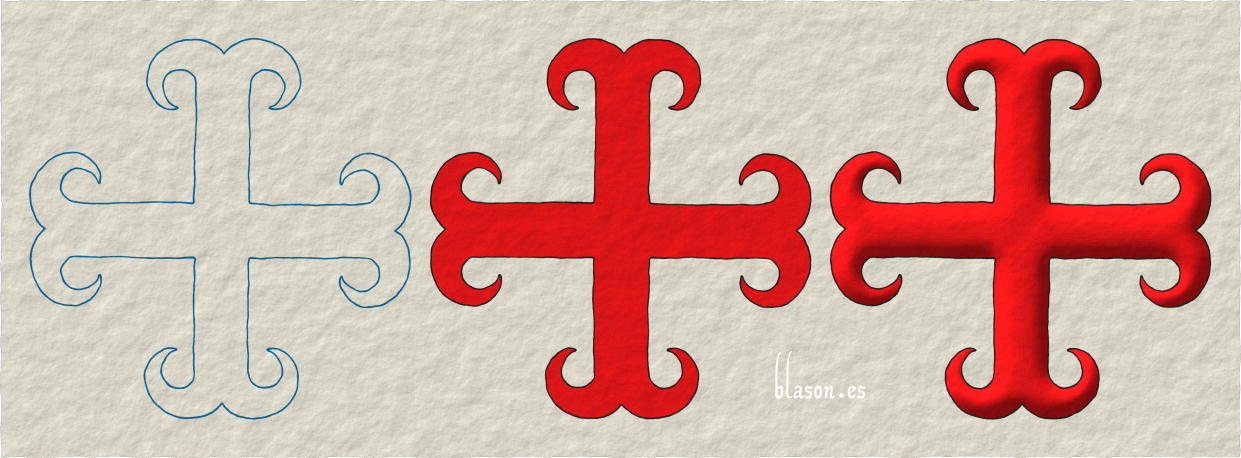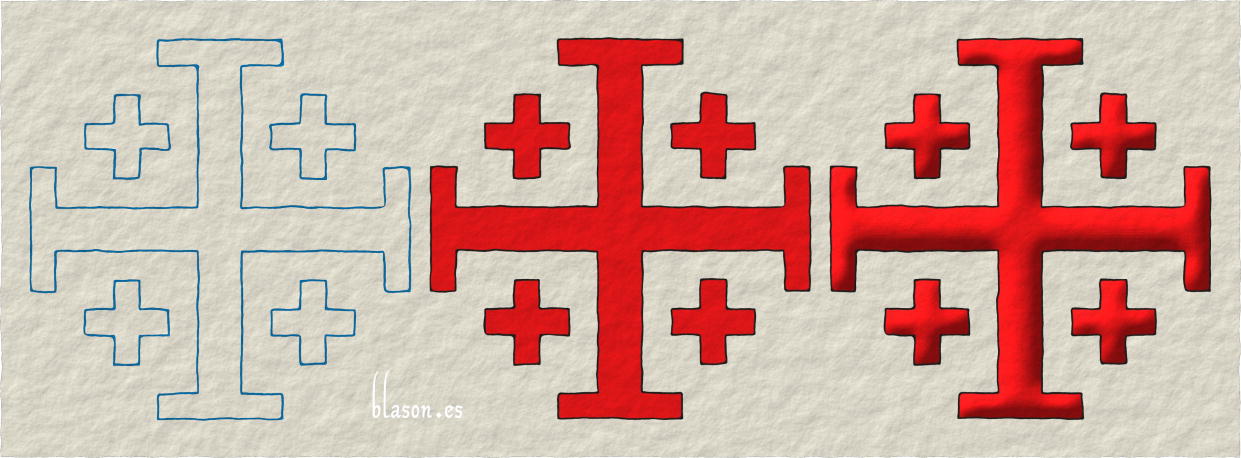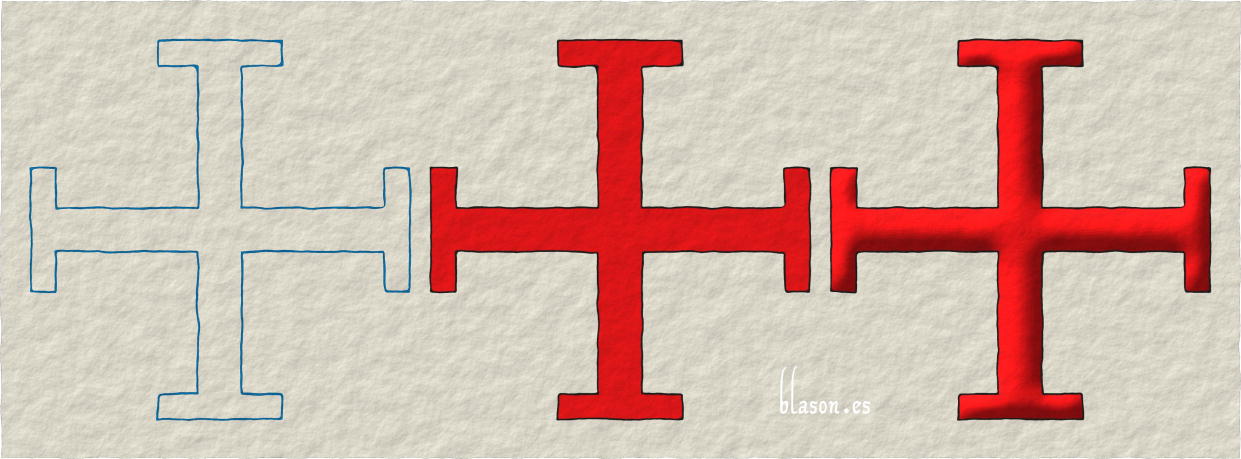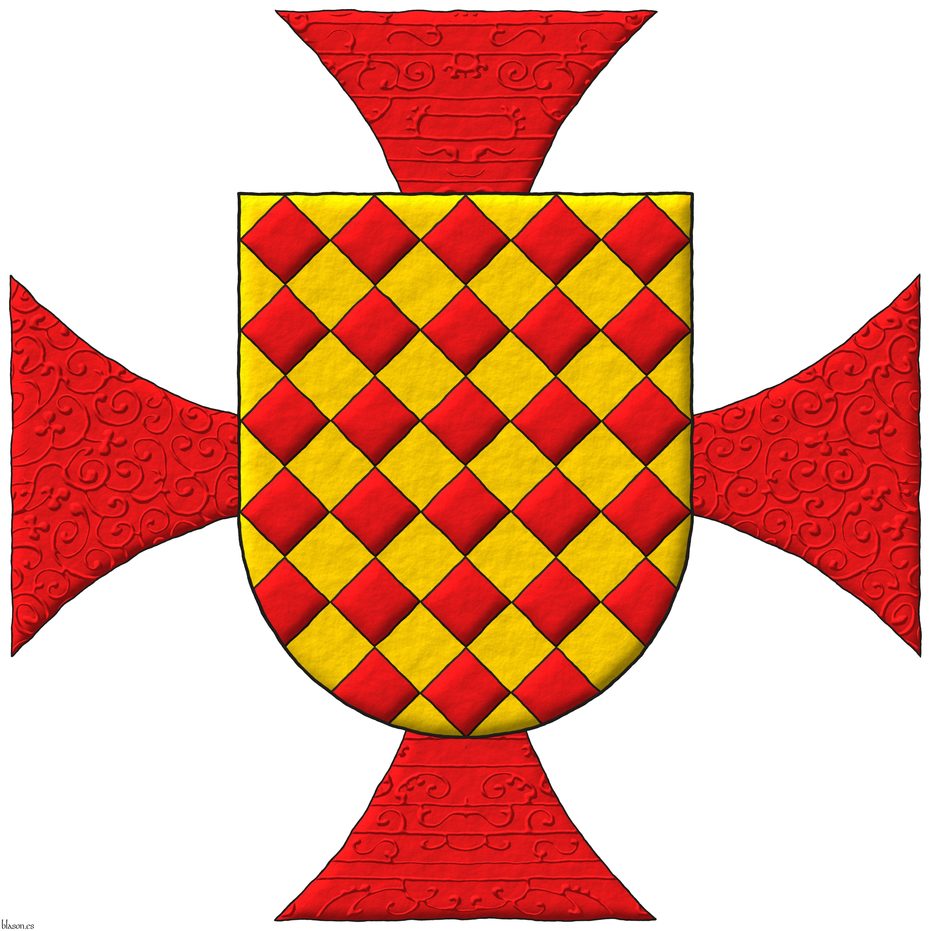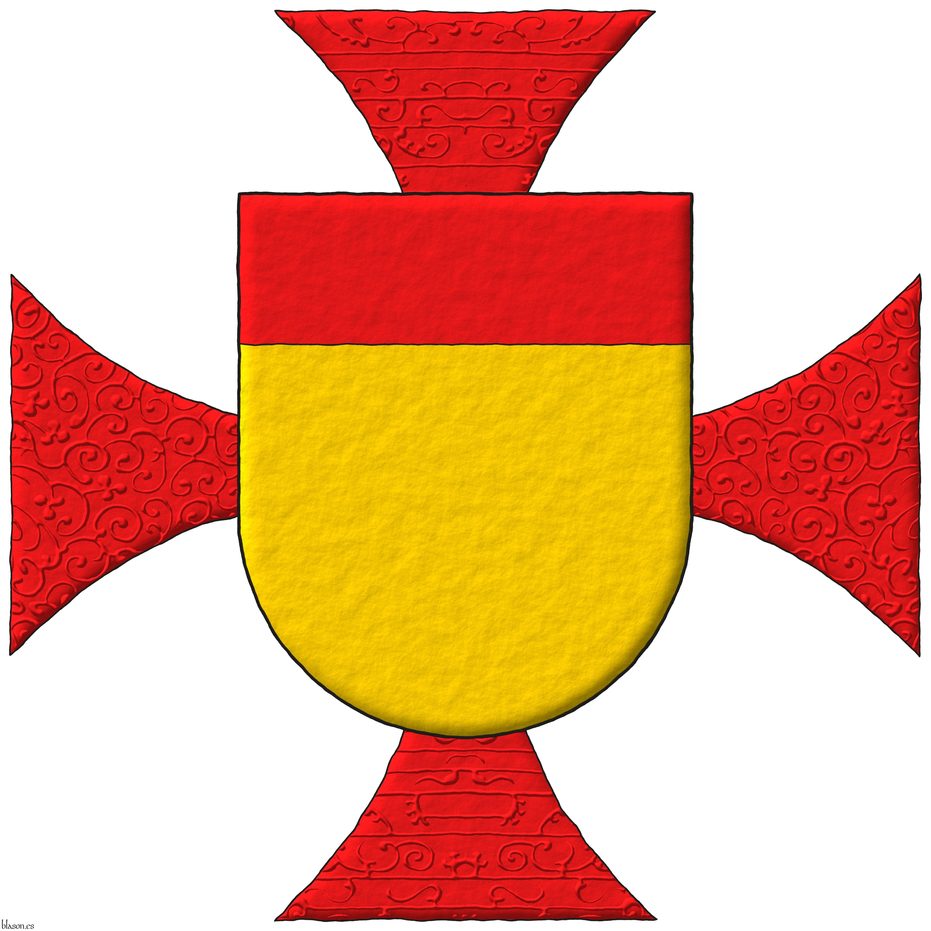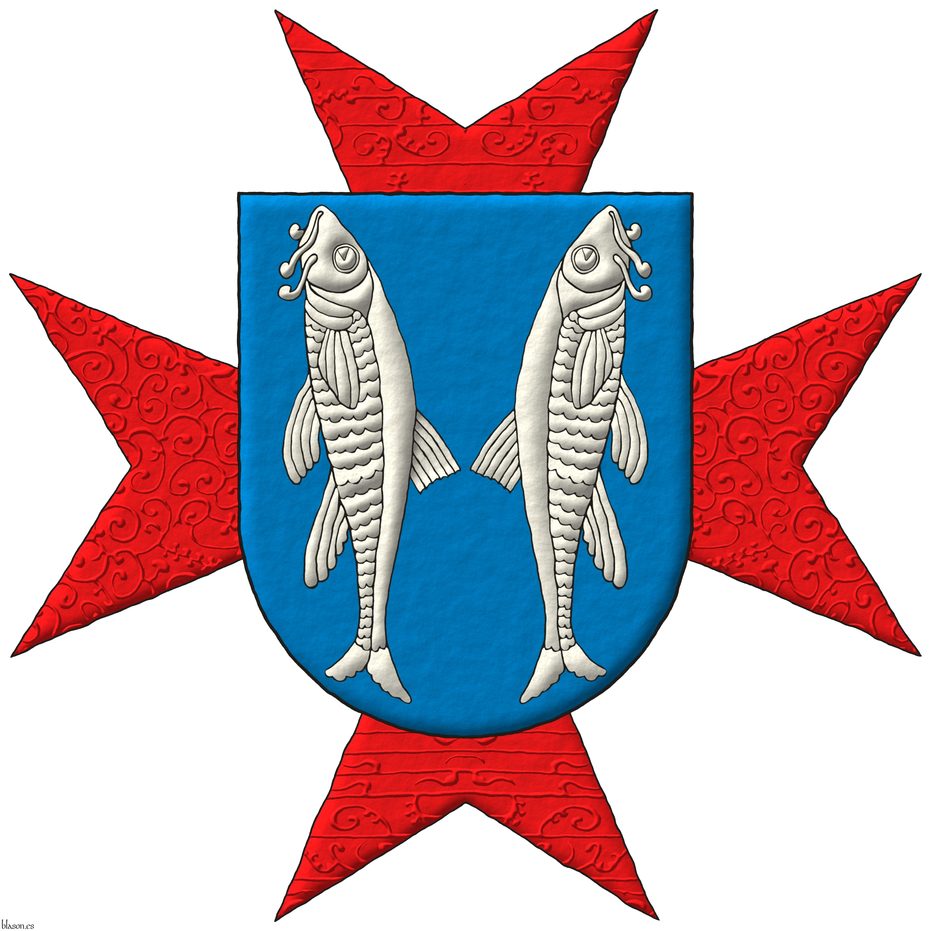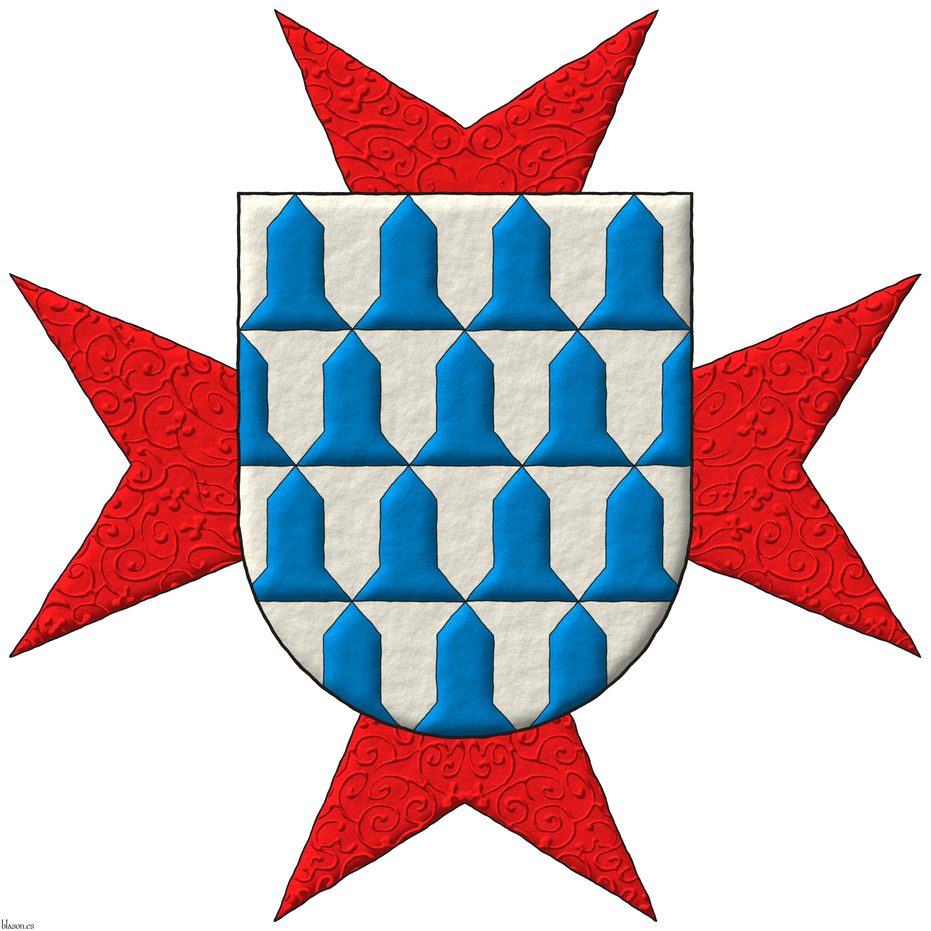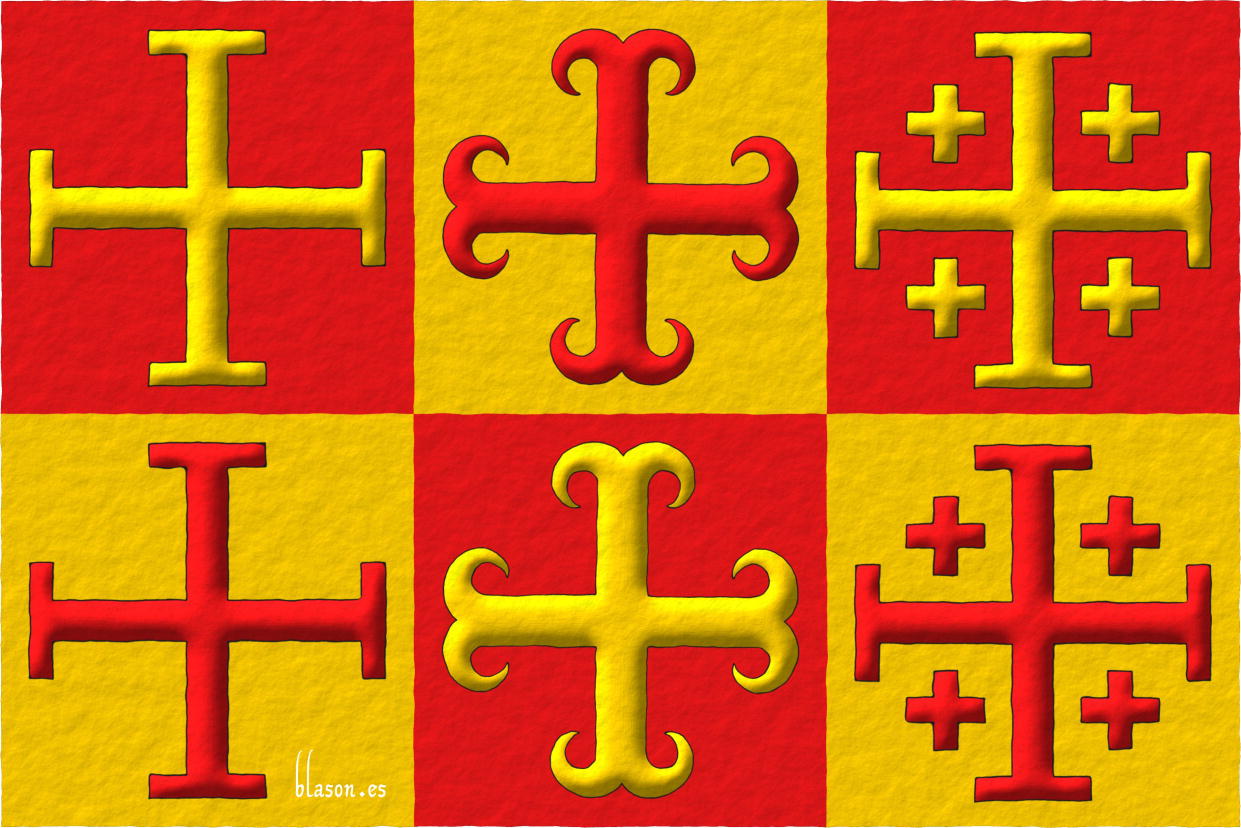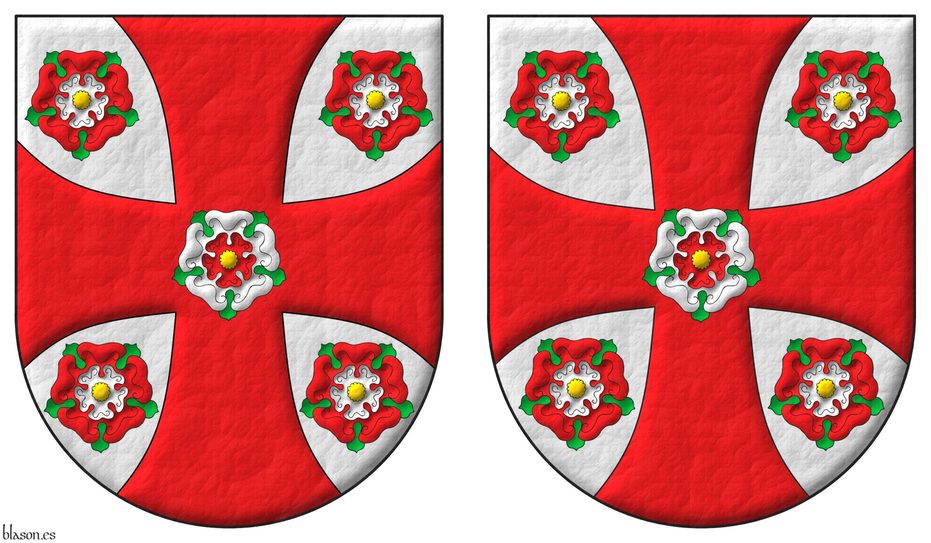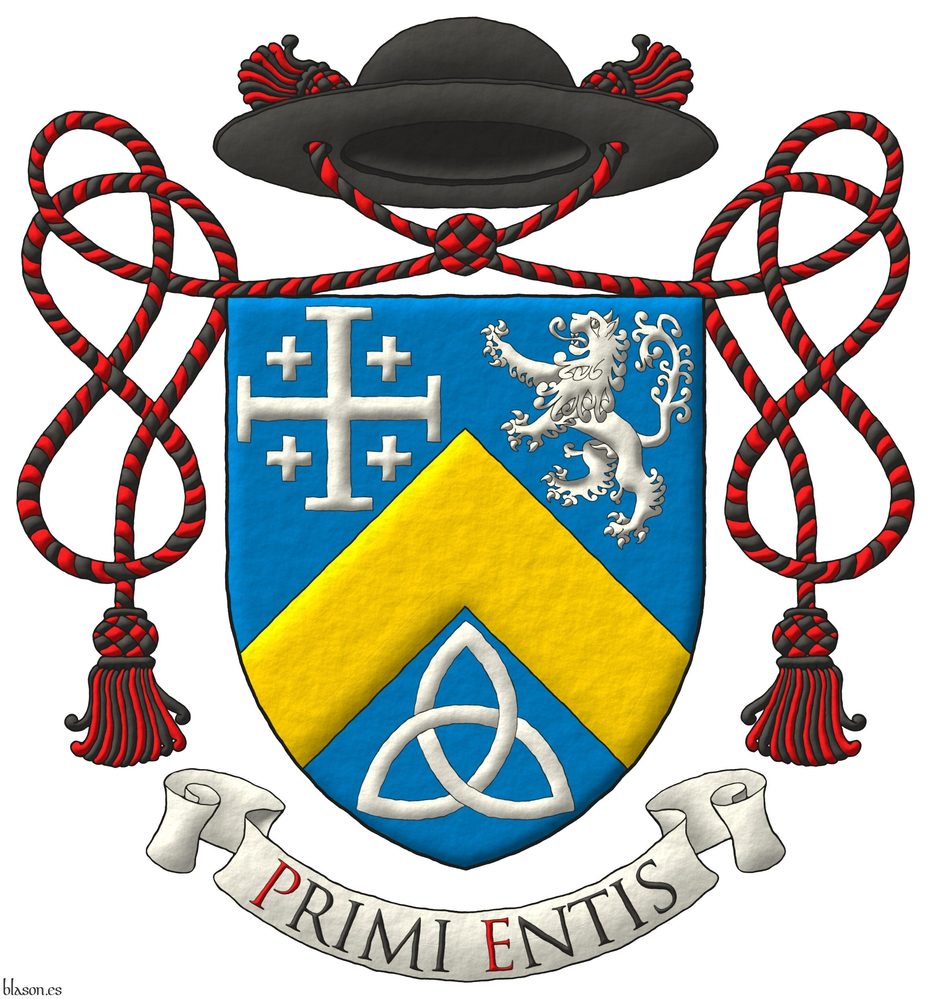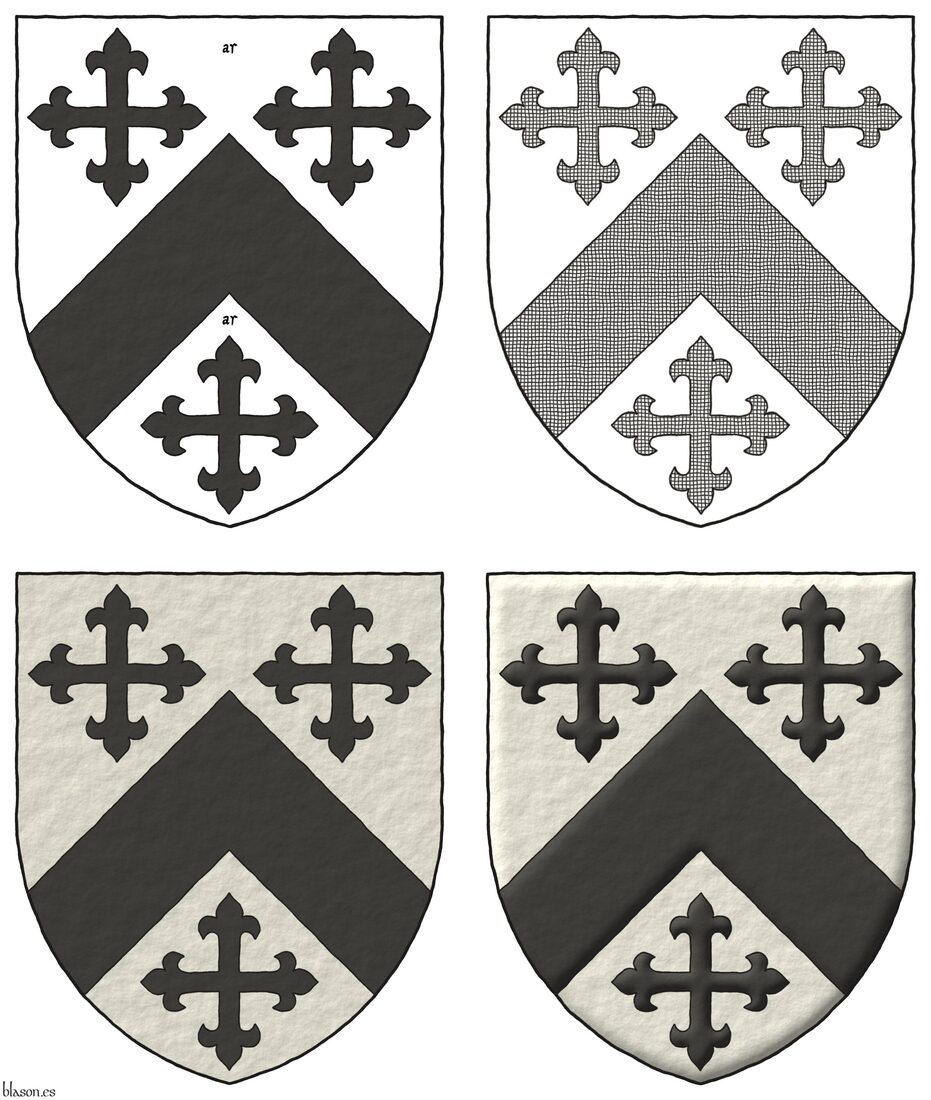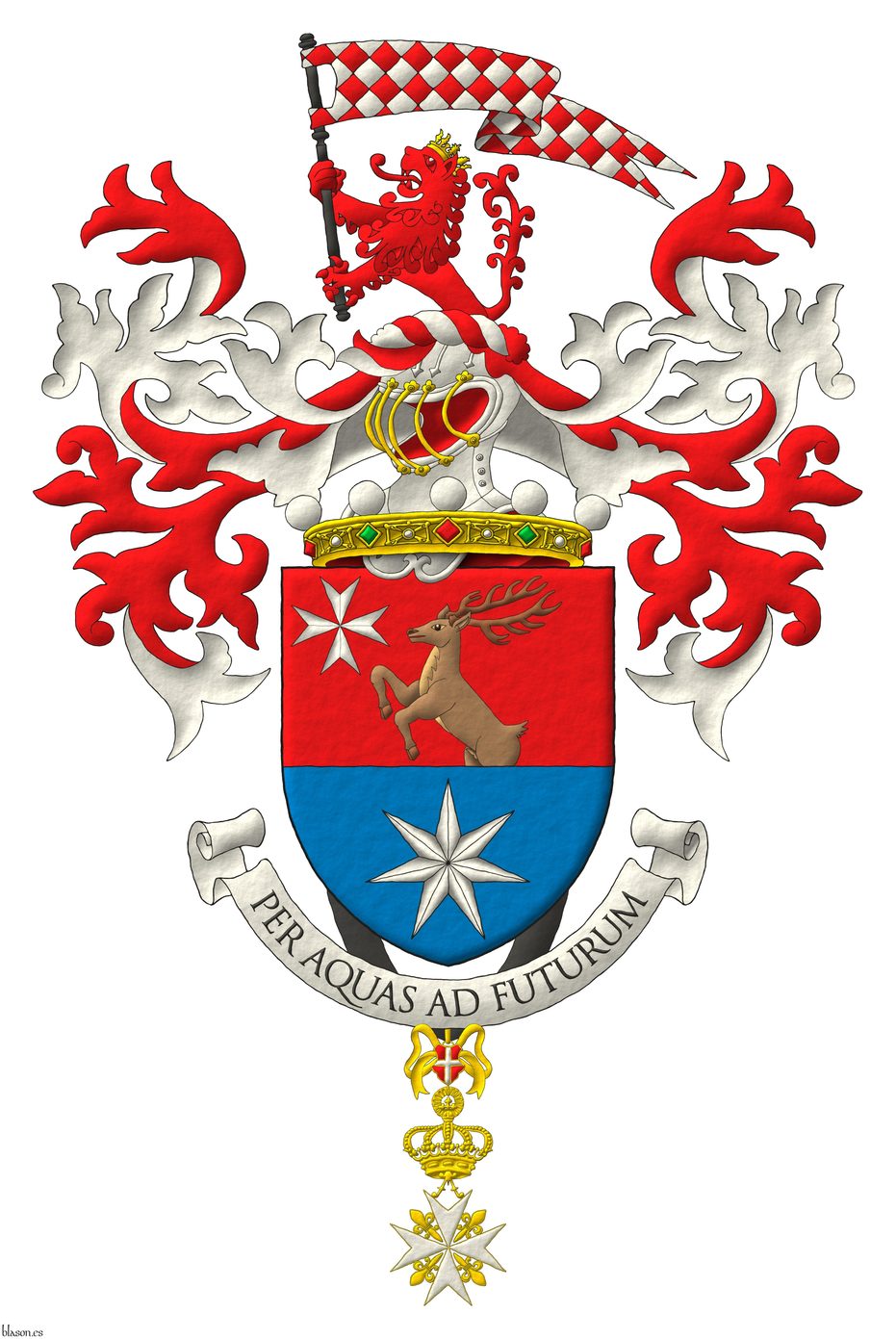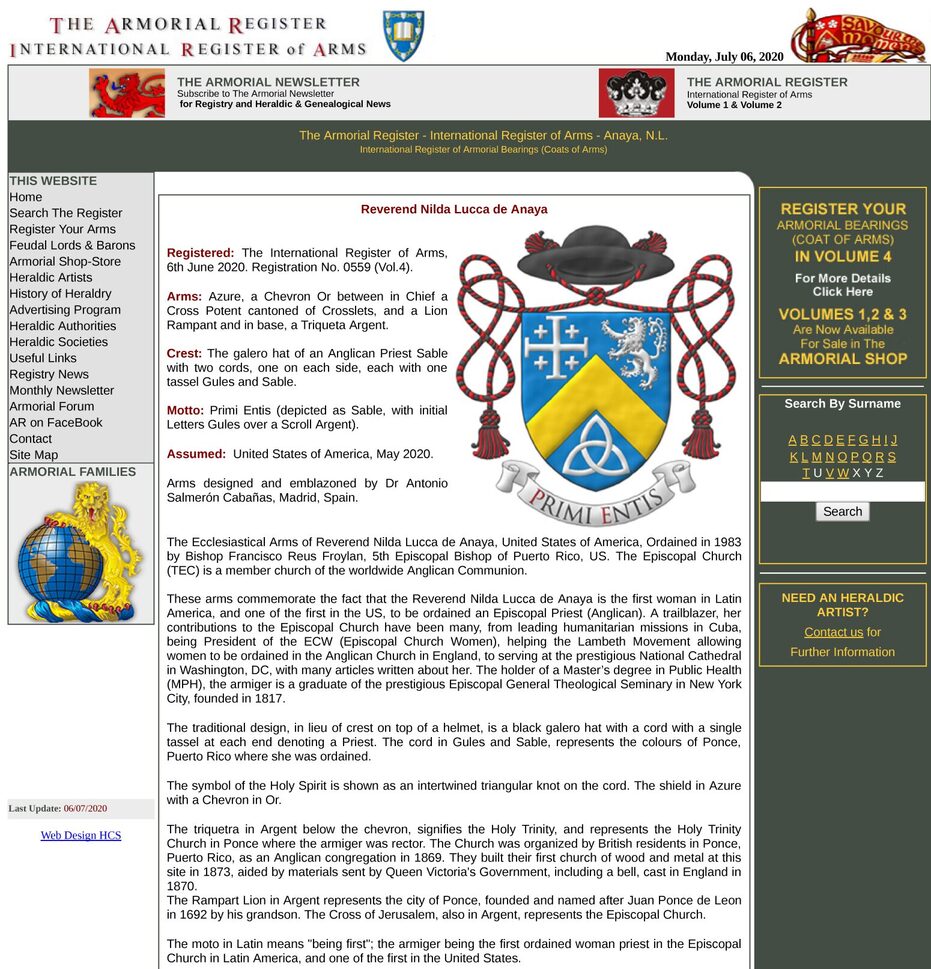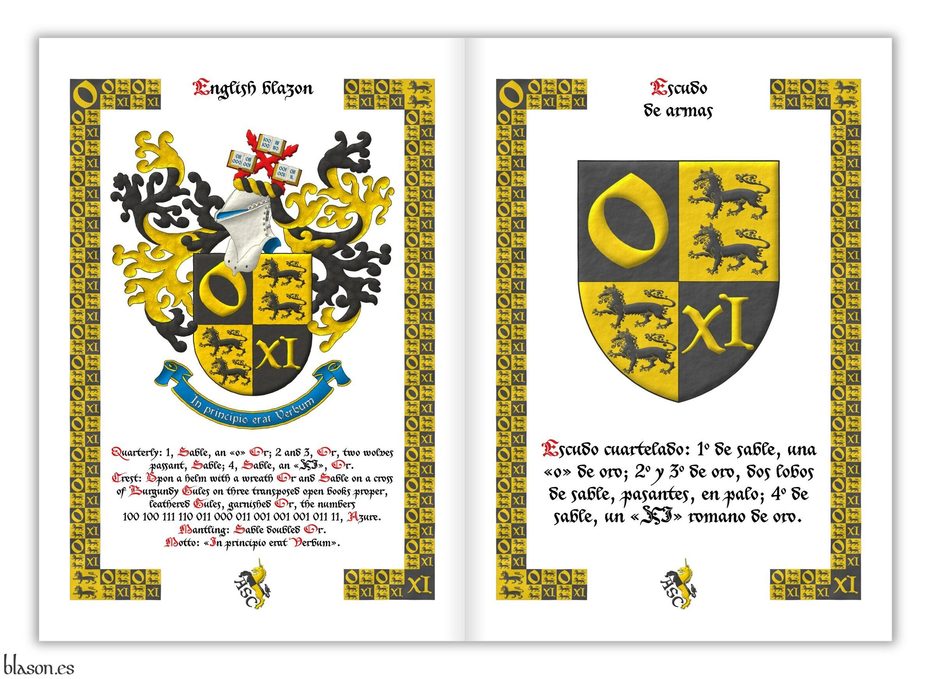Cross couped

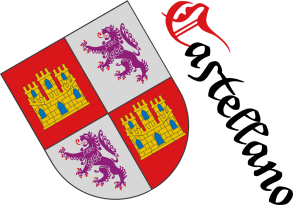
Robert de Craon
Lozengy Or and Gules. Behind the shield a cross patty Gules.
Blazon keywords: Lozengy, Or, Gules, Behind the shield, One, Cross patty and Cross couped.
Style keywords: Outlined in sable, Illuminated, Semi-circular and Freehand.
Classification: Religious, Military, Knights Templar, Interpreted and Coat of arms.
Bearer: Craon, Robert de.


Bernard de Tremelay
Or, a chief Gules. Behind the shield a cross patty Gules.
Blazon keywords: Or, Chief, Gules, Behind the shield, One, Cross patty and Cross couped.
Style keywords: Outlined in sable, Semi-circular, Illuminated and Freehand.
Classification: Religious, Military, Knights Templar, Interpreted and Coat of arms.
Bearer: Tremelay, Bernard de.


André de Montbard
Azure, two barbels addorsed Argent. Behind the shield an eight-pointed cross patty Gules.
Blazon keywords: Azure, Two, Barbel, Addorsed, Argent, Behind the shield, One, Eight-pointed cross, Cross couped and Gules.
Style keywords: Outlined in sable, Semi-circular, Illuminated and Freehand.
Classification: Religious, Military, Knights Templar, Interpreted and Coat of arms.
Bearer: Montbard, André de.


Quartered arms of Bertrand de Blanchefort
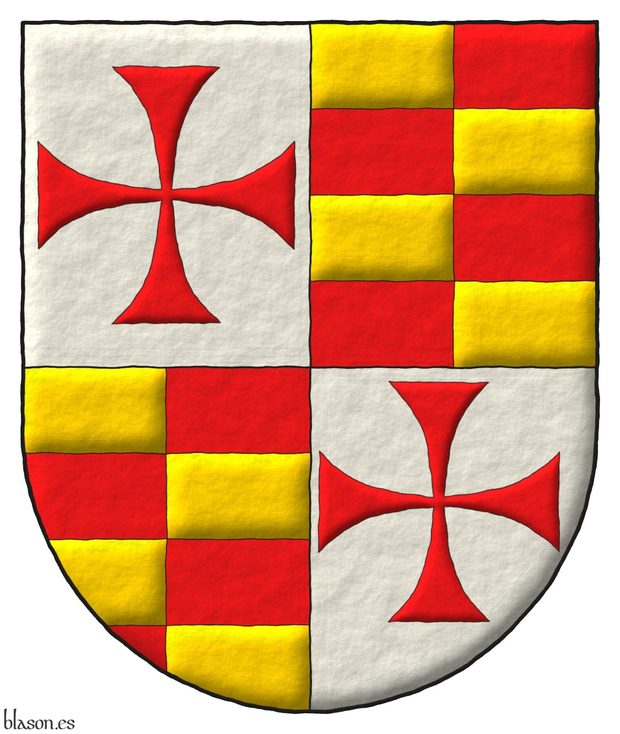
Quarterly: 1 and 4 Argent, a cross patty Gules; 2 and 3 Barry of four per pale counterchanged Or and Gules.
Escudo cuartelado: 1o y 4o de plata, una cruz patada de gules; 2o y 3o de contrafajado de cuatro piezas de oro y gules.
Blazon keywords: Barry per pale counterchanged, Four, Or, Gules, Quarterly, Argent, One, Cross patty and Cross couped.
Style keywords: Outlined in sable, Semi-circular, Illuminated and Freehand.
Classification: Religious, Military, Knights Templar, Interpreted and Coat of arms.
Bearer: Blanchefort, Bertrand de.


Quartered arms of Gilbert Hérail
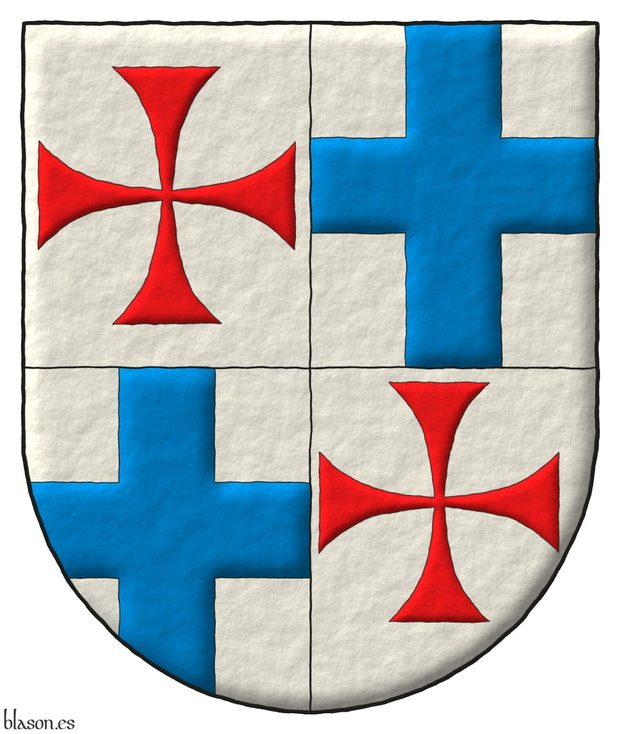
Quarterly: 1 and 4 Argent, a cross patty Gules; 2 and 3 Argent, a cross Azure
Escudo cuartelado: 1o y 4o de plata, una cruz patada de gules; 2o y 3o de plata, una cruz de azur.
Blazon keywords: Argent, One, Cross, Azure, Quarterly, Cross patty, Cross couped and Gules.
Style keywords: Outlined in sable, Illuminated, Semi-circular and Freehand.
Classification: Religious, Military, Knights Templar, Interpreted and Coat of arms.
Bearer: Hérail, Gilbert.


Quartered arms of Richard de Bures
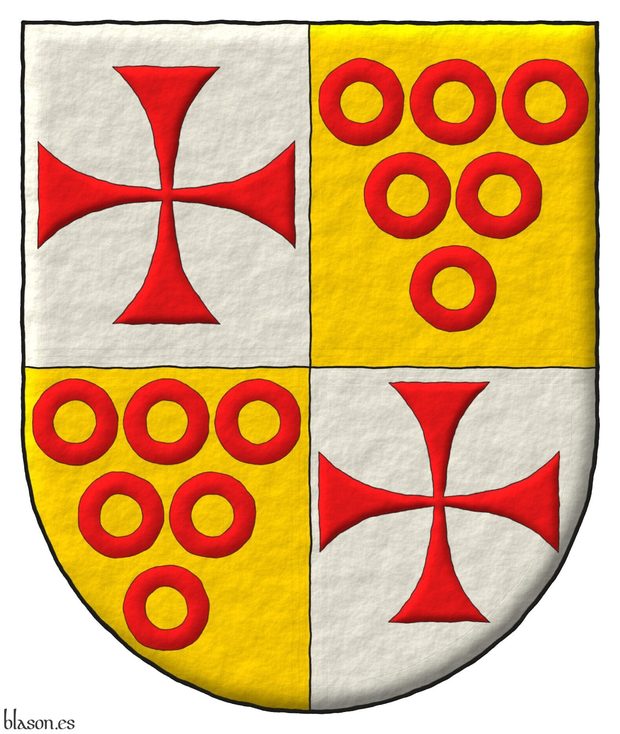
Quarterly: 1 and 4 Argent, a cross patty Gules; 2 and 3 Or, six annulets Gules, 3, 2, and 1.
Escudo cuartelado: 1o y 4o de plata, una cruz patada de gules; 2o y 3o de de oro, seis anilletes de gules, ordenados 3, 2 y 1.
Blazon keywords: Or, Six, Annulet, Gules, Ordered, Three, Two, One, Quarterly, Argent, Cross patty and Cross couped.
Style keywords: Outlined in sable, Semi-circular, Illuminated and Freehand.
Classification: Religious, Military, Knights Templar, Interpreted and Coat of arms.
Bearer: Richard, Richard.


Renaud de Vichiers
Vair. Behind the shield an eight-pointed cross patty Gules.
Blazon keywords: Vair, Behind the shield, One, Eight-pointed cross, Cross couped and Gules.
Style keywords: Outlined in sable, Illuminated, Semi-circular and Freehand.
Classification: Religious, Military, Knights Templar, Interpreted and Coat of arms.
Bearer: Vichiers, Renaud de.


Quartered arms of Jacques de Molay
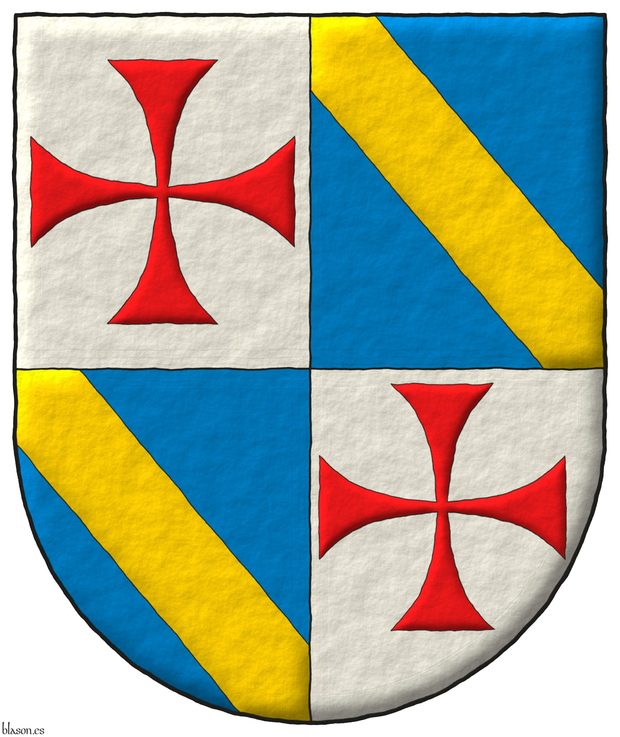
Quarterly: 1 and 4 Argent, a cross patty Gules; 2 and 3 Azure, a bend Or
Escudo cuartelado: 1o y 4o de plata, una cruz patada de gules; 2o y 3o de azur, una banda de oro.
Blazon keywords: Azure, One, Bend, Or, Quarterly, Argent, Cross patty, Cross couped and Gules.
Style keywords: Outlined in sable, Illuminated, Semi-circular and Freehand.
Classification: Religious, Military, Knights Templar, Interpreted and Coat of arms.
Bearer: Molay, Jacques de.


Tercio Great Captain
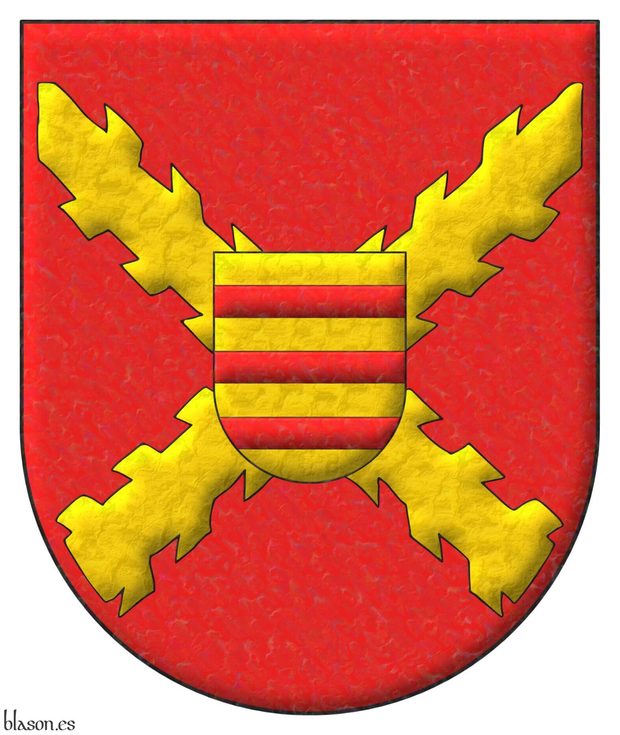
Gules, a cross of Burgundy Or; an inescutcheon Or, three bars Gules.
Escudo de gules, una cruz de Borgoña de oro; un escusón de oro, tres fajas de gules.
Arms painted by me, illuminated with lights and shadows, outlined in Sable, with a semi-circular outer contour and with a metal beaten finish.
Coat of arms of the Tercio Great Captain, 1st of the Spanish Legion, emblazoned by me. The inescutcheon represents the coat of arms of Gonzalo Fernandez de Cordoba, 1453-1515, known as «The Great Captain». During the Italian campaigns in the late 15th and early 16th centuries, especially during the wars of Naples, Gonzalo Fernandez de Cordoba reformed the Spanish army, adapting it to the new conditions of Renaissance warfare. He created a flexible tactical system based on the combination of pikemen, inspired by the Swiss; «espingarderos», forerunners of the arquebusiers; and «espadas» or shock troops, this combination would form the foundation of the future «Tercios».
Blazon keywords: Gules, Or, One, Three, Cross of Burgundy, Cross couped, Inescutcheon, Bar and Fess.
Style keywords: Outlined in sable, Illuminated, Semi-circular and Metal beaten.
Classification: Military, Interpreted, Boa and Coat of arms.
Bearer: Tercio Great Captain.


Tercio Alessandro Farnese, plain tincture
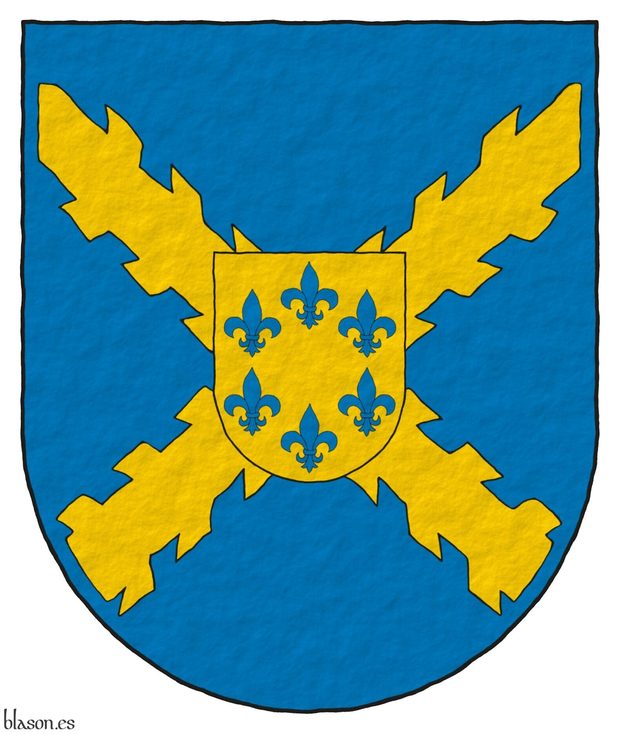
Azure, a cross of Burgundy Or; an inescutcheon Or, six fleurs de lis in orle Azure.
Coat of arms depicted by me, in plain tinctures, outlined in Sable, with a semi-circular external shape and with a texturized finishing.
Coat of arms of the Tercio Alessandro Farnese, 4th of the Spanish Legion, emblazoned by me. In 1956, the fourth Tercio of the Spanish Legion was created and named Tercio Alessandro Farnese in his honor. The inescutcheon has in orle the 6 fleurs the lis of the Farnese family.
Blazon keywords: Azure, Or, One, Six, Cross of Burgundy, Cross couped, Inescutcheon, Fleur de lis and In orle.
Style keywords: Outlined in sable, Plain tincture and Semi-circular.
Classification: Military, Interpreted, Boa and Coat of arms.
Bearer: Tercio Alessandro Farnese.


Cross potent, cross moline, and cross of Jerusalem, comparison
A Gules and Or comparison between cross potent, cross moline, and cross of Jerusalem
Blazon keywords: Gules, Or, Cross potent, Cross couped, Cross moline, Cross of Jerusalem and Cross.
Style keywords: Freehand, Outlined in sable and Illuminated.
Classification: Schema.


Antonio José Gómez Morillo
Argent, a cross patty Gules charged with a double rose Argent and Gules, barbed Vert, seeded Or, between four double roses Gules and Argent, barbed Vert, and seeded Or.
Coats of arms emblazoned by me with a shapes ended with semi-circular arches, illuminated, and with a leather finishing.
Once his roses have been selected (their kind, number, and layout), I redesign the shape of the cross patty to adapt it to his roses, and I redistribute the surfaces of metal Argent and color Gules looking for a more equilibrate artwork. This evolution does not change the blazon.
Blazon keywords: Argent, One, Cross patty, Cross couped, Gules, Charged, Double rose, Barbed, Seeded, Between and Four.
Style keywords: Semi-circular, Outlined in sable, Illuminated and Leather.
Classification: Personal, Created and Coat of arms.
Bearer: Gómez Morillo, Antonio José.


Grzeszkowiak, Tomasz Arkadiusz
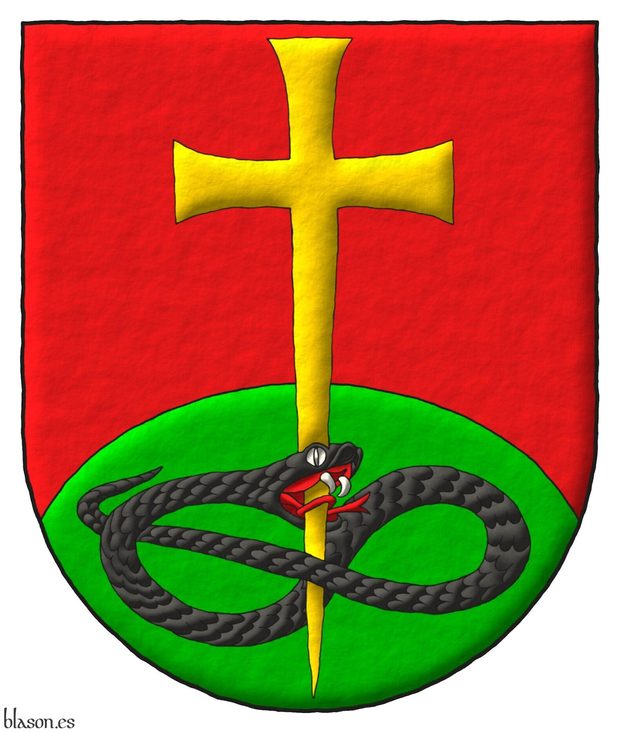
Gules, a base enarched Vert, overall a cross patty fitchy Or, piercing in base the head of a serpent nowed and facing sinister Sable, langued Gules.
I have interpreted this coat of arms with a semi-circular shape; tintures or, sable, vert and gules; outlined with sable; and a freehand finish.
In Polish heraldic tradition the color Sable can be over other colors, the color Vert in this case. The following bibliographical references can be consulted about the Polish use of the color Sable over other colors:
- [Bakala, K.; 2010; page 17] has written «nie pozwala nakladania metalu na metal, a barwy na barwe, za wyjatkiem barwy czarnej i purpurowej» ~ «does not allow to put metal on metal and color on color, except the color Sable and Purpure», notice that Sable and Purpure are the neutral colors whilst Gules, Azure and Vert are energetic colors.
- [Marecki, J.; 2012; page 67] has written about the rule of colors and metals «wyjatkiem byla czern, która laczono zarówno z metalami, jak i z innymi barwami» ~ «the exception was black, which was combined with both metals and other colors».
Blazon keywords: Without divisions, Gules, One, Mount, Vert, Issuant from base, Overall, Cross patty fitchy, Cross couped, Piercing, Head, Serpent, Nowed, Facing sinister, Sable and Langued.
Style keywords: Semi-circular, Freehand and Outlined in sable.
Classification: Interpreted, Personal and Coat of arms.
Bearer: Grzeszkowiak, Tomasz Arkadiusz.


Austin Charles Berry
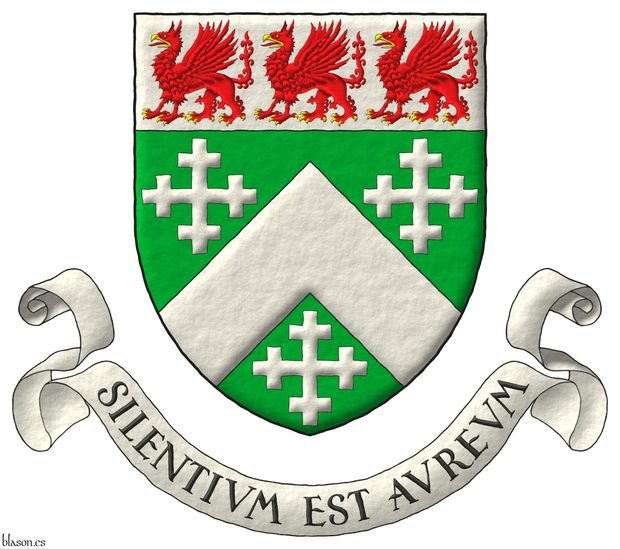
Vert, a chevron, between three cross-crosslets; on a chief Argent, three griffins statant Gules, beaked and armed Or. Motto: «Silentium est aureum».
Escudo de sinople, un cabrio, acompañado de tres cruces recrucetadas; un jefe todo de plata, tres grifos parados de gules, picados y armados de oro. Lema: «Silentium est aureum».
Blazon keywords: Vert, One, Chevron, Between, Three, Cross-crosslet, Cross couped, Chief, Argent, Griffin, Statant, Gules, Beaked, Armed, Or and Motto.
Style keywords: Pointed, Outlined in sable, Illuminated and Freehand.
Classification: Personal, Interpreted, Coat of arms and Latin language.
Bearer: Berry, Austin Charles.


Commoners' certification Jacques William Normand Delfin
Azure, on three bars wavy Argent, a Norman ship Or, full sail Argent; on a chief Gules, two leopards Or, armed and langued Azure; a bordure Argent charged with eight acorns bendwise Azure. Crest: Upon a helm with a wreath Or and Azure, a cross of Lorraine patty Or. Mantling: Azure doubled Or. Motto: «Marche dans ta voie avec Dieu».
This is the Commoners' Certification of Arms of Dr. Jacques William Normand Delfin, his arms have been designed by him and me, and emblazoned by me.
Blazon keywords: Azure, Argent, Or, Gules, One, Two, Eight, In base, On, Wavy, Bar, Norman ship, Full sail, Chief, Leopard, Armed, Langued, Bordure, Acorn, Bendwise, Upon (wreath), Helm, Wreath, Cross of Lorraine, Cross couped, Patty, Mantling, Doubled and Motto.
Style keywords: Outlined in sable, Illuminated and Ogee.
Classification: Personal, Created, Boa, Certification, Heraldic document and Flag.
Bearer: Normand Delfin, Jacques William.


Crest and mantling of Chad Michael Krouse
Party per chevron Gules and barry wavy Argent and Azure, in chief two Dogwood flowers (Cornus Florida) proper, in base a Cross of Saint Chad Gules. Crest: A Cardinal's head (Cardinalis cardinalis) erased clutching in its Beak a Madonna lily (Lilium Candidum) seeded proper. Mantling: Gules doubled Argent.
Coat of arms emblazoned by me, highlighted with lights and shadows, outlined in Sable, with an ogee external shape and with a leather finish.
Blazon keywords: Gules, Argent, Azure, Two, One, Party per chevron, Barry, Wavy, In chief, Dogwood flower, Flower, Proper, In base, Cross of Saint Chad, Cross couped, Crest, Head, Erased, Grasping, Beak and Mantling.
Style keywords: Outlined in sable, Illuminated, Ogee and Leather.
Classification: Personal, Interpreted, Boa and Coat of arms.
Bearer: Krouse, Chad Michael.


Galero and motto of Nilda Ernestina Lucca de Anaya
Azure, a chevron Or, between in chief a cross potent cantoned of crosslets, and a lion rampant, and in base a Celtic Trinity knot Argent. Crest: A galero Sable, with two cords, each with one tassel Gules and Sable. Motto: «Primi entis» Sable, with initial letters Gules, over a scroll Argent.
Credits:
- Ernesto Juan Anaya is the designer of the coat of arms.
- Antonio Salmerón y Cabañas is the author of the heraldic art.
Blazon keywords: Azure, One, Chevron, Or, Between, In chief, Cross of Jerusalem, Cross couped, Cross potent, Cantoned, Four, Crosslet, Lion, Rampant, In base, Celtic Trinity knot, Knot, Celtic, Trinity, Crest and mantling, Galero, Cord, Tassel, Scroll, Charged and Motto.
Style keywords: Outlined in sable, Illuminated, Pointed and Freehand.
Classification: Religious, Interpreted, Coat of arms and Latin language.
Bearer: Lucca de Anaya, Nilda Ernestina.


Anderson of Erbury
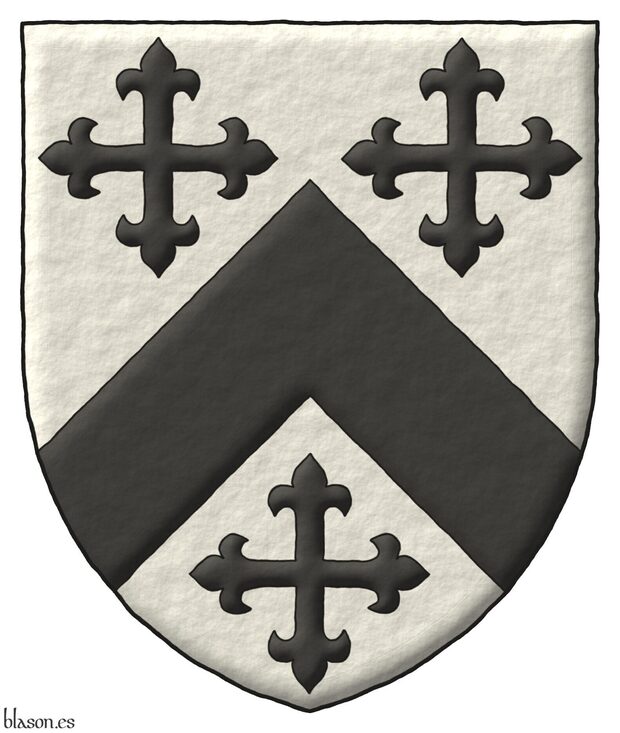
Argent, a chevron between three crosses flory Sable.
Escudo de plata, un cabrio acompañado de tres cruces flordelisadas todo de sable.
Illuminated with lights and shadows and with a freehand finish.
The coat of arms of Anderson of Erbury emblazoned by me in 4 ways: 1) tricking using abbreviations, 2) hatching using lines, 3) plain tinctures, and 4) lights and shados. It is a preliminary artwork for the arms of Nick Allen Rica II.
Blazon keywords: Without divisions, Argent, One, Chevron, Between, Three, Cross flory, Cross couped and Sable.
Style keywords: Freehand, Outlined in sable, Illuminated, Pointed, Tricking, Hatching and Plain tincture.
Classification: Interpreted, Kingdom of Scotland and Schema.
Bearer: Anderson of Erbury.


Kingdom of Jerusalem
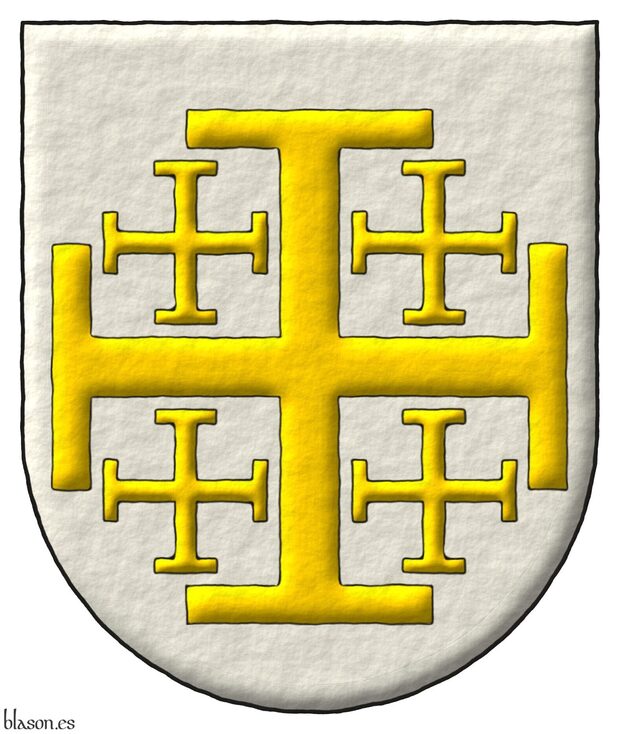
Metal Or over metal Argent.
Argent, a cross potent cantoned of four crosslets potent Or.
Escudo de plata, una cruz potenzada cantonada de cuatro cruces potenzadas todas de oro.
Illuminated with lights and shadows and with a freehand finish.
Perhaps the most classic example of non-compliance with the heraldic rule of tinctures having metal Or over metal Argent. In [Galdiano L.; Century XVII; folio 6], you can see a version of the arms of Jerusalem with the field in Gules, which would indeed follow the rule of tinctures as it is metal on color.
Blazon keywords: Without divisions, Argent, One, Cross potent, Cross couped, Cantoned, Four and Or.
Style keywords: Freehand, Outlined in sable, Illuminated, Semi-circular and Metal on metal.
Classification: Interpreted and Civic.
Bearer: Kingdom of Jerusalem.


Henry of Castile, Infante
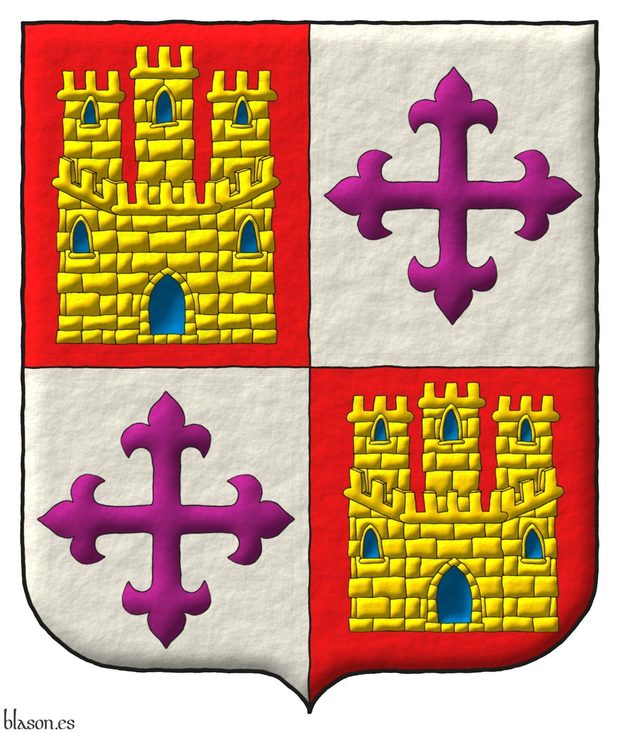
Quarterly: 1 and 4 Gules, a castle triple-towered Or, port and windows Azure, and masoned Sable; 2 and 3 Argent, a cross flory Purpure.
Escudo de cuartelado: 1o y 4o de gules, un castillo de oro, aclarado de azur, mazonado de sable; 2o y 3o de plata, una cruz flordelisada de púrpura.
Arms depicted by me, illuminated with lights and shadows, contoured in Sable, with an ogee external shape and with a freehand finish.
Coat of arms of the Infante Henry of Castile, 1230–1303, 6th offspring of the King Ferdinand III of Castile, 1199-1252, and the Queen Beatrice of Swabia, 1205–1235. He bore his father's arms, replacing the lion Purpure of the Kingdom of León with a cross flory Purpure, likely due to his close association with the Order of Calatrava, whose emblem is a cross flory Gules. However, he retained the metal Argent field in the 2nd and 3rd quarters and the lion's purple color, suggesting this was more of a conceptual change than a quartering by alliance with the Order of Calatrava.
Blazon keywords: Gules, Or, Azure, Sable, Argent, Purpure, One, Quarterly, Castle, Triple-towered, Port and windows, Masoned, Cross flory and Cross couped.
Style keywords: Outlined in sable, Illuminated, Ogee and Freehand.
Classification: Personal, Interpreted, Boa and Coat of arms.
Bearer: Henry of Castile, Infante.


Bella, Giovanni de
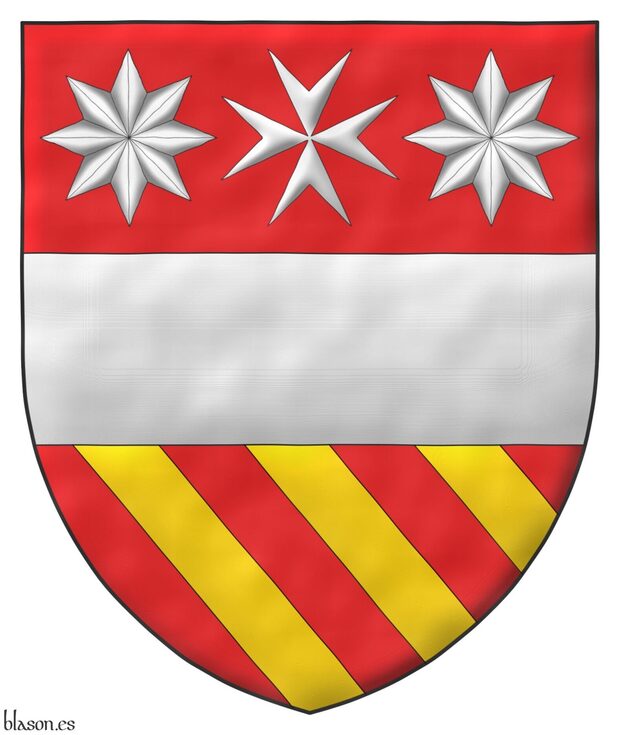
Gules, a fess between, in chief a Maltese cross between two mullets of eight points Argent, in base three bendlets Or.
Coat of arms emblazoned by me with a pointed shape, illuminated, and with a watercolor finishing.
G0053, Chief Herald of Malta's grant of Giovanni de Bella's arms, whose coat of arms has been emblazoned by me.
Blazon keywords: Gules, One, Fess, Between, In chief, Eight-pointed cross, Cross couped, Two, Mullet, Eight, Argent, In base, Three, Bendlet and Or.
Style keywords: Outlined in sable, Illuminated, Watercolor and Pointed.
Classification: Personal, Interpreted and Coat of arms.
Bearer: Bella, Giovanni de.


Laurent Liu-Lecomble, structured and parallel blazons
Coat of arms of Laurent Liu-Lecomble designed by him and emblazoned by me, with the blazon written in English and Castilian in a structured way to observe the parallelism between both forms.
Blazon keywords: Azure, Argent, Gules, Or, One, Three, Quarterly, Dexter, Hand, Appaumée, Sword, Point upwards, Between, Cross patty, Cross couped, Sinister, Eight-pointed cross, Plough share, Affronty, Disordered, Eagle claw, Inescutcheon, Charged and Fleur de lis.
Style keywords: Outlined in sable, Illuminated, Ogee and Rough.
Classification: Personal, Interpreted, Structured and parallel blazons, Boa and Coat of arms.
Bearer: Liu-Lecomble, Laurent.


Halkosaari, Heikki
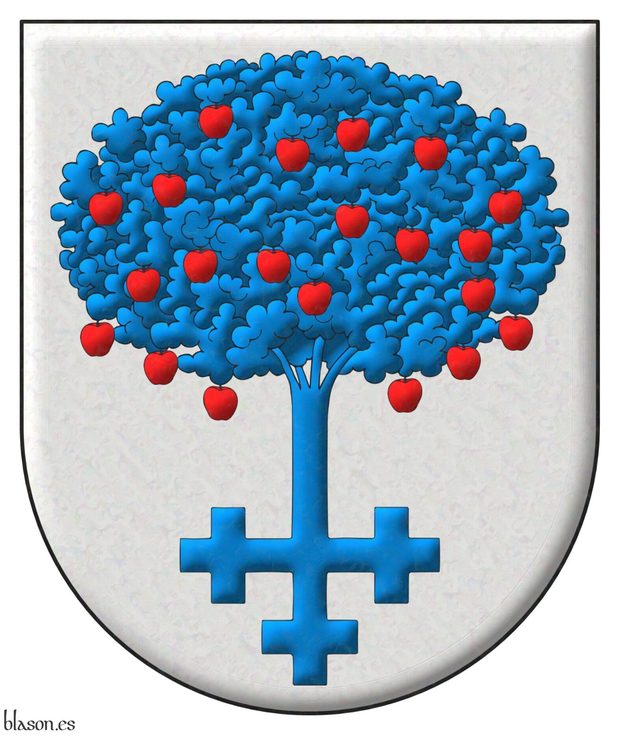
Argent, an apple tree, the base of its trunk forming a cross crosslet Azure, fructed Gules.
Escudo de plata, un manzano con la punta del tronco en forma de cruz recrucetada de Azur, frutado de gules.
Coat of arms painted by me, highlighted with lights and shadows, contoured in Sable, with a semi-circular external shape and with a iridescent finishing.
Blazon keywords: Argent, Azure, Gules, One, Apple tree, Base, Trunk, Cross, Crosslet, Cross couped and Fructed.
Style keywords: Outlined in sable, Illuminated, Semi-circular and Iridescent.
Classification: Personal, Interpreted, Boa and Coat of arms.
Bearer: Halkosaari, Heikki.


Sister Esperanza Vega Lanzagorta, outlined

Azure, between two palm fronds in pile reversed a Lady of Mercy grasping in her sinister hand a broken chain Argent, and charged on the chest with an escutcheon per fess, 1 Gules, a cross patty Argent, and 2 Or, four pallets Gules.
This is the coat of arms of Sister Esperanza Vega Lanzagorta, designed by Juan Lanzagorta Vallin and outlined by me. These arms have a representation of Our Lady of Mercy, celebrated on September 24th. To identify Our Lady of Mercy, I chose two primary symbols: 1) The arms of the Order of Mercy on her chest, «per fess, 1 Gules, a cross patty Argent, and 2 Or, four pallets Gules», and 2) the broken chains, symbolizing the redemption of captives, remember that the complete name of the order is the Royal, Celestial, and Military Order of Our Lady of Mercy and the Redemption of the Captives.
Credits: Juan Lanzagorta Vallin is the designer of the coat of arms.
Blazon keywords: Azure, Argent, Gules, Or, One, Two, Our Lady of Mercy, Grasping, Sinister, Hand, Broken, Chain, Charged, Chest, Escutcheon, Party per fess, Cross patty, Cross couped, Between, Palm frond and In pile reversed.
Style keywords: Outlined and Semi-circular.
Classification: Personal, Created, Boa and Coat of arms.
Bearer: Vega Lanzagorta, Sister Esperanza.


Kathleen Kane
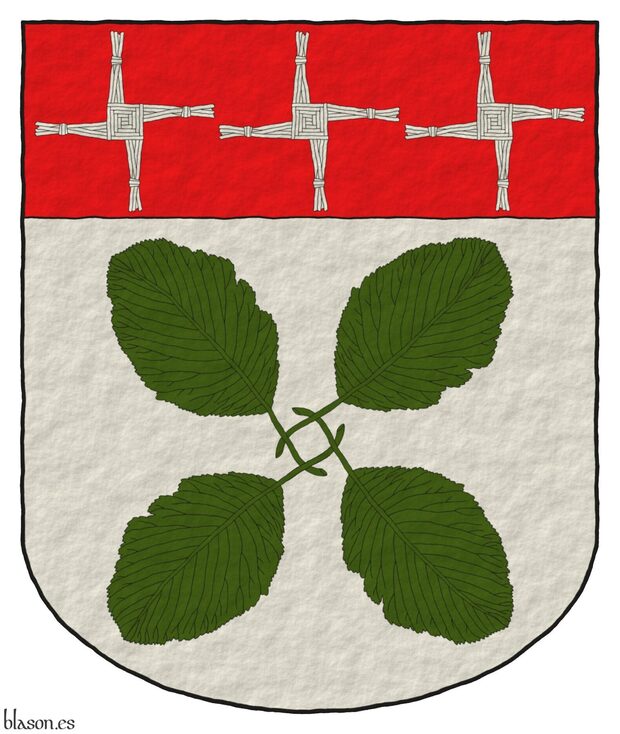
Argent, four leaves of Silver Leaved Whitebeam (Sorbus Aria Lutescens) in saltire, stems interlaced Vert, on a chief Gules, three crosses of Saint Brigid Argent.
Escudo de plata, cuatro hojas de serbal blanco (Sorbus Aria Lutescens) en sotuer, los tallos entrelazados de sinople, en un jefe de gules, tres cruces de santa Brígida de plata.
Blazon keywords: Argent, Four, Leaf, In saltire, Stem, Interlaced, Vert, Chief, Gules, Three, Cross of Saint Brigid and Cross couped.
Style keywords: Outlined in sable, Rounded and Plain tincture.
Classification: Personal, Interpreted and Coat of arms.
Bearer: Kane, Kathleen.


Full achievement of Jay Geoffrey De Graaf
Party per fess, 1 Gules, a stag rampant, issuant from base proper, in the dexter chief a Maltese cross Argent; 2 Azure, a mullet of seven points Argent. Crest: Upon a helm befitting his degree issuant from a crown of Noble above the shield, with a wreath Argent and Gules, a demi-lion Gules, crowned Or, grasping in its paws a swallow-tailed pennon lozengy Gules and Argent, shafted Sable. Mantling: Gules doubled Argent. Motto: «Per Aquas Ad Futurum». Suspended from the shield, the cross of Knight of Magistral Grace of the Sovereign Military Order of Malta.
Coat of arms painted by me, highlighted with lights and shadows, contoured in Sable, with a pointed external shape and with a freehand finish.
G0131, augmentation of G0042, Chief Herald of Arms of Malta's grant for the arms of Jay Geoffrey De Graaf, Australia. The augmentation consists of the addition of a Maltese cross Argent in the dexter chief. These arms have been emblazoned by me for such grant.
Blazon keywords: Gules, Azure, Argent, Or, One, Party per fess, Stag, Rampant, Issuant from base, Proper, In the dexter chief, Eight-pointed cross, Cross couped, Mullet, Crest, Upon (wreath), Helm, Issuant, Crown of Noble, Crown, Above the shield, Wreath, Demi, Lion, Crowned, Grasping, Paw, Swallow-tail, Lozengy, Shafted, Mantling, Motto, Suspended from the shield and Decoration.
Style keywords: Outlined in sable, Illuminated, Pointed and Freehand.
Classification: Personal, Interpreted, Boa, Coat of arms, Pennon and Flag.
Bearer: Graaf, Jay Geoffrey De.


Nilda Ernestina Lucca de Anaya, The Armorial Register
Registered by The International Register of Arms, 6th of June of 2020, Registration number 0559, Volume 4.
Categories: Armorial roll, Azure, Chevron, Between, In chief, Cross of Jerusalem, Cross couped, Cross potent, Cantoned, Crosslet, Lion, Rampant, In base, Celtic Trinity knot, Knot, Celtic, Trinity and Scroll.
External resource:
Root: The Armorial Register.


My heraldic channel at WhatsApp is whatsapp.com/channel/0029VbAV5sk3LdQbvWgP4p43 or blason.es/whatsapp.
Categories: Technology, Social networks, Lion, Rampant, Armed, Langued, Label, Behind the shield, Eight-pointed cross and Cross couped.


o-XI, heraldic document
Heraldic document, 2 pages.
The pages have a heraldic frame with the elements of his coat of arms.
The motto, which is the beginning of the Gospel of Saint John, can be seen in [Cnut Gospels; 1020; folio 111].
Blazon keywords: Quarterly, Sable, Or, One, Letter, Two, Wolf, Passant, In pale, Number, Gules, Argent, Azure, Crest and mantling, Helm, Mantling, Wreath, Crest, On, Charged, Disordered, Cross, Cross of Burgundy, Cross couped, Book, Open, Motto, Scroll and Fimbriated.
Classification: Created, Personal, Catalogue, Heraldic document and Frame.
Bearer: Salmerón Cabañas, Antonio.


![Ver [Royal Council of the Orders of Chivalry] en instituciones citadas. Fortaleza de oro y mazonada de sable.](../css/Fortaleza.Institucion.png)
Royal Council of the Orders of Chivalry

In 1523, the Order of Santiago, the Order of Calatrava, and the Order of Alcantara were definitively incorporated into the Crown of Castile, which marked the consolidation of the Royal Council of the Orders of Chivalry of Santiago, Calatrava, Alcantara, and Montesa. However, it is known that this Royal Council already existed at the beginning of the same 16th century, or even earlier, although there are no foundational documents available to date its inception.
The internet address of its website is ordenesmilitares.es where it also hosts the pages dedicated to each of its four orders:
- Order of Chivalry of Santiago: ordenesmilitares.es/orden-de-santiago.
- Order of Chivalry of Calatrava: ordenesmilitares.es/orden-de-calatrava.
- Order of Chivalry of Alcantara: ordenesmilitares.es/orden-de-alcantara.
- Order of Saint Mary of Montesa and Saint George of Alfama: ordenesmilitares.es/orden-de-montesa.
After the Crusades ended and following the model of the military orders created in the Holy Land, European kings established Orders of Chivalry, many of which were military and religious institutions, like the four grouped under this Royal Council.
Categories: Institution, Interpreted, Socioeconomic, Illuminated, Outlined in sable, Freehand, Emblem, Cross, Quarterly per saltire, Cross of Saint James, Cross couped, Cross of Calatrava, Cross of Alcantara and Cross of Montesa.


Order of Santiago, emblem
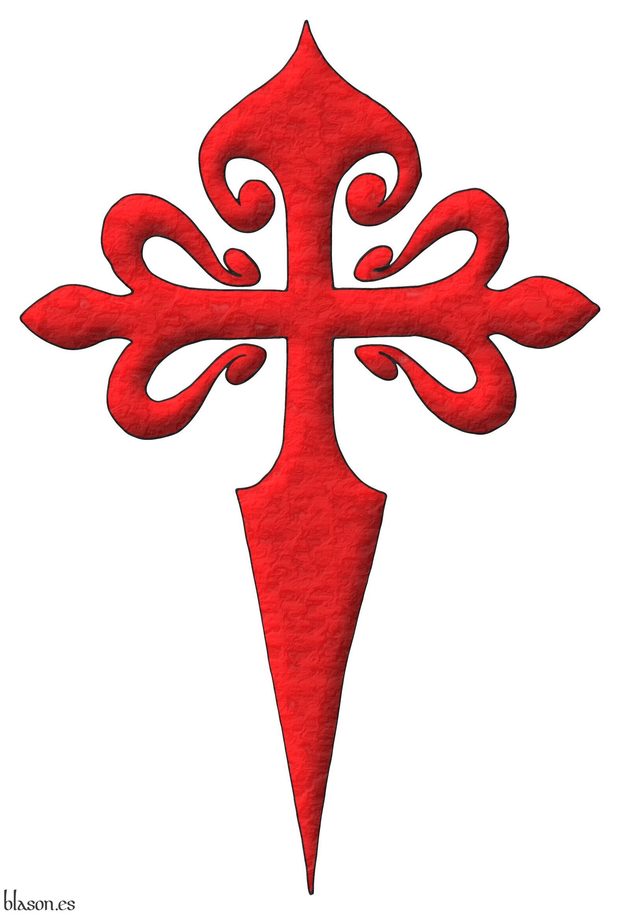
Order of Chivalry of Santiago
A cross of Saint James.
Una cruz de Santiago.
Interpretation of the emblem of the order with: its cross outlined in Sable, illuminated in Gules; and a heavily hammered metal finish.
The Royal Council of the Orders of Chivalry of Santiago, Calatrava, Alcantara, and Montesa, in its historical account of the foundation of the Order of Santiago, describes three different points of view:
- The one presented by tradition, which establishes it in 844, after the battle of Clavijo, when fourteen knights led by the Field Master Don Sancho Martínez de Tejada requested permission from Don Ramiro I, king of Asturias between the years 842 and 850, to found it. This traditional view is the one recorded in [Avilés, J.; 1780b; treatise IV, chapter II, page 325] when discussing the origin of the «Military Order of Santiago of the Sword».
- The perspective of historians like Claudio Sánchez Albornoz or Américo Castro, who question the earlier date. Furthermore, [Sánchez Albornoz, C.; 1965; pages 94-136], as cited in [Domínguez García, J.; 2008; pages 69-70], proposes that the actual battle of Clavijo occurred later, in the year 859, and that Ramiro I did not participate, but rather it was a conflict between King Ordoño I and the Moor Muza.
- The view of historians who, based on the statutes of the order found in the Monastery of Uclés, which was the residence of the Master of the Order of Santiago, and the Latin in which they are written, believe that the foundation could indeed date back to the reign of Don Ramiro I.
Emblem
Regarding the emblem of the Order of Chivalry of Santiago, [Avilés, J.; 1780b; treatise IV, chapter II, page 328, plate 25, figure 100] states «the Commandery of this Order was always a red Sword» (gules ~ red), «in the form of a Cross, just as the guards of the ancient Swords that its Knights and Commanders carried on their white Mantles, and today also on the chest in the same manner, hanging from a red ribbon on a gold medal; that is, in a field of Or, a Cross of Gules».
Blazon keywords: Cross of Saint James, Cross couped and Cross.
Style keywords: Illuminated, Outlined in sable and Soft metal.
Classification: Interpreted, Religious, Military and Emblem.
Bearer: Santiago, Order of.


![Ver [Calatrava, Order of] en instituciones citadas. Fortaleza de oro y mazonada de sable.](../css/Fortaleza.Institucion.png)
Calatrava, Order of
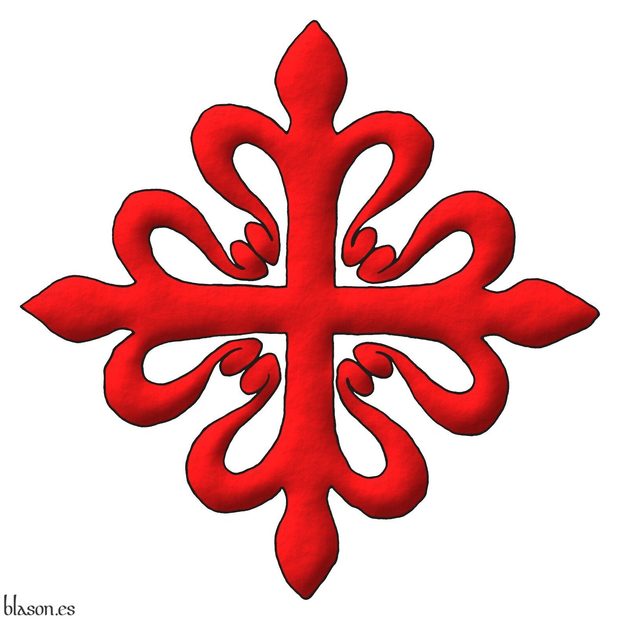
The Order of Chivalry of Calatrava is both military and religious, founded in the Kingdom of Castile during the 12th century by Abbot Raymond of Fitero.
The purpose of its foundation was the protection of the town of Calatrava la Vieja, which currently belongs to the municipality of Carrión de Calatrava in Ciudad Real. At the time of the order's foundation, it was an important city, in the middle valley of the river Guadiana and with a strategic position, as it was a necessary passage on the road from Toledo to Córdoba to Toledo and between the west and east of the Iberian Peninsula.
On the origin and antiquity of the Military Order of Calatrava, and the form of its Commandery
[Avilés, J.; 1780b; treatise IV, chapter IV, pages 334] writes «The Military Order of Calatrava was instituted by Don Sancho III, King of Castile (called the Desired), in the year 1158, while he was visiting his Kingdom; and being in Toledo with news of the great army that the Moors were gathering to besiege Calatrava la Vieja (which is called so today to distinguish it from the new one, which was founded later); and as the Templars, to whom this Fortress belonged, did not have sufficient power to resist such a large multitude, they handed it over to King Don Sancho himself so that he could take charge of it, as he did».
[Avilés, J.; 1780b; treatise IV, chapter IV, page 335] continues by telling us «The Abbot of Santa María de Fitero», near the river Pisuerga as he will indicate next, «of the Congregation of Cistercian, in the Bishopric of Palencia (which is a Monastery of St. Bernard, located on the river Pisuerga), named Don Raymond, and Friar Diego Velazquez, his subject Monk, who followed the Court, despite the difficulty of the enterprise, requested it from the King to defend it, which was granted, trusting in the virtue of the Abbot, and the strength of the Monk, who had previously been a great Knight in deeds of Arms, and very practiced in war».
[Avilés, J.; 1780b; treatise IV, chapter IV, page 336] continues «Seeing themselves in such an obligation, and that by themselves they could not fulfill it, they turned to Archbishop Don Juan (who was the fourth of Toledo) for help; and he, granting many indulgences in all his Archbishopric to those who, for themselves and for others, supplied the Place with provisions, in the same way as those who, unable to go due to old age or illness, helped with weapons, horses, and men; and having spread this news, so much help came to them, that when the Moors learned that the number of people exceeded twenty thousand men, they abandoned the conquest, returning to their homes: for this reason, the King ceded the Town of Calatrava to the Abbot of Fitero, and his successors, to defend it from the Moors from then on, confirmed later by King Alfonso IX, his son».
[Avilés, J.; 1780b; treatise IV, chapter IV, page 337] concludes «Having obtained this grace, Abbot Don Raymond brought the most suitable Monks from Fitero to Calatrava, and everything else that was necessary for living and for the defense of the Town and its land, which with the people inclined to war who remained, formed the Order of Chivalry of Calatrava, taking this name from the place where the institution was made, which in Arabic Calatrava means Castle».
Categories: Institution, Interpreted, Religious, Military, Illuminated, Outlined in sable, Freehand, Emblem, Cross of Calatrava, Cross couped and Cross.


Jamilena, province of Jaen
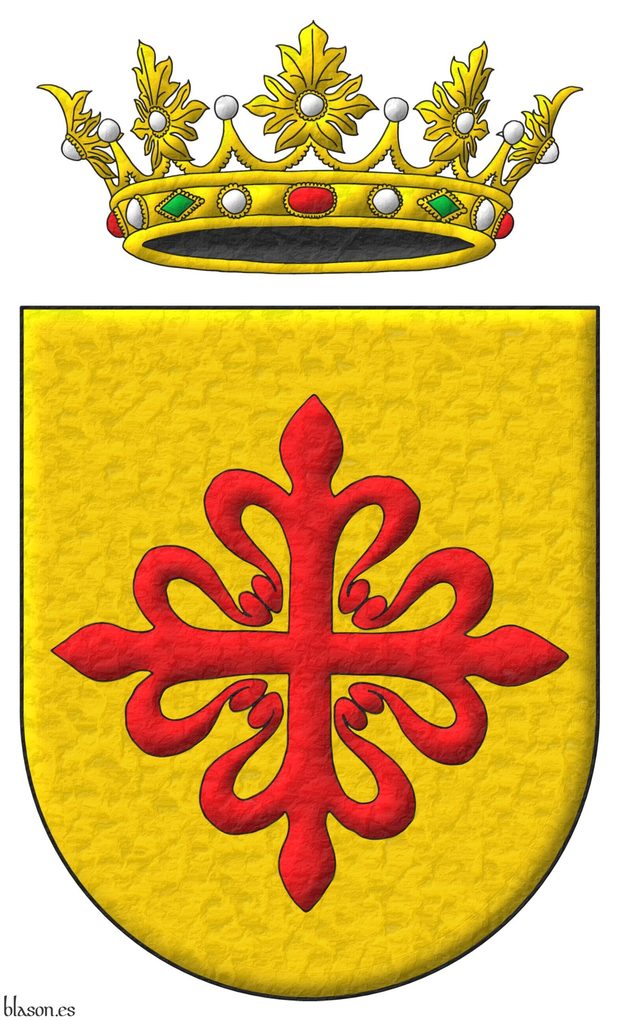
Or, a cross of Calatrava. Crest: An open royal crown Or.
Escudo de oro, una cruz de Calatrava. Timbrado de una corona real abierta.
Coat of arms interpreted as follows: the shield's shape is a semicircular arch; the field is illuminated in metal Or; the cross of Calatrava is outlined in Sable and illuminated in Gules; the royal crown is open, outlined in Sable and illuminated in metal Or, pearls in Argent, gemstones in Gules and Vert, and the visible base hollow in Sable; and the entire piece has a slightly hammered metal finish.
The municipality of Jamilena belongs to the La Campiña region and is the smallest in the province of Jaén. I have depicted its coat of arms with an open royal crown, but representations with a closed royal crown can also be found.
The origin of the cross of Calatrava in its heraldic coat of arms dates back to the year 1525 when Emperor Charles V issued several decrees from Toledo to build a convent for nuns in Jamilena. For the construction of this convent, stones from the Muslim castle, which was reformed and occupied by the Order of Calatrava, were used.
Blazon keywords: Without divisions, Or, Cross of Calatrava, Cross couped, Cross, Crest, Open royal crown and Crown.
Style keywords: Semi-circular, Illuminated, Outlined in sable and Soft metal.
Classification: Interpreted, Civic and Coat of arms.
Bearer: Jamilena.


Order of Alcantara, emblem
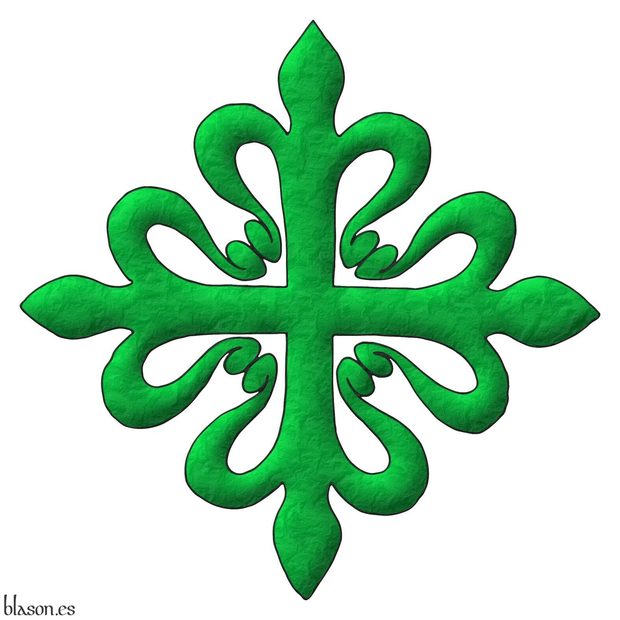
Order of Cavalry of Alcantara
A cross of Alcantara.
Una cruz de Alcántara.
Interpretation of the emblem of the order with: its cross outlined in Sable, illuminated in Vert; and a heavily beaten metal finish.
The Royal Council of the Orders of Chivalry of Santiago, Calatrava, Alcantara, and Montesa, in its historical account of the foundation of the Order of Alcantara, states that, according to Alonso de Torres y Tapia, Prior of Alcantara and a 17th-century chronicler, it was founded in 1156, by Don Suero Fernández Barrientos along with other knights from Salamanca, in Pereiro near the River Coa, under the name of the Order of Saint Julian of Pereiro and during the reign of Ferdinand II of León.
Emblem
Regarding the emblem of the Order of Cavalry of Alcantara, [Avilés, J.; 1780b; treatise IV, chapter V, page 340, figure 102], reusing the same figure 102 as for the Order of Calatrava, says «In the past, the Order of Alcantara displayed on its Standard the Gules Straps of Calatrava», remember that due to the commandery of the city of Alcantara, they had to assume some dependency on that of Calatrava, «next to a Pear tree in Vert on a field of Or, which was the insignia of the Order of Pereiro, due to the conformity with which these two Orders lived; but upon changing their Habit, the Pope» Eugene IV «granted them the green Cross», Vert, «in the manner they wear it today, differing from that of Calatrava only in color».
Blazon keywords: Cross of Alcantara, Cross couped and Cross.
Style keywords: Illuminated, Outlined in sable and Soft metal.
Classification: Interpreted, Religious, Military and Emblem.
Bearer: Alcantara, Order of.


Cavalry Regiment Alcantara, Laureate of Saint Ferdinand
Grand Laureate Cross of Saint Ferdinand.
Argent, a cross of Alcantara. Crest: A closed royal crown Or, with eight arches, visible five. Behind the shield the Laureate Grand Cross of Saint Ferdinand. Motto: «Hoec nubila tollunt obstantia sicut sol».
Escudo de plata, una cruz de Alcántara. Timbrado de una corona real cerrada. Acolada detrás del escudo la gran cruz laureada de San Fernando. Lema: «Hoec nubila tollunt obstantia sicut sol».
Coat of arms interpreted in the following manner: the shape of the shield is of a semicircular arch; the field is illuminated in metal Argent; the cross of Alcantara, the 4 swords and the 2 laurel branches are outlined in Sable and illuminated in Vert and Gules; the royal crown is closed, outlined in Sable and illuminated with the metal Or, Argent for the pearls, Azure and Or for the orb, Gules and Vert for the gems, Gules for the inner cloth, and Sable for the visible hollow at its base; and the whole has a iridescent finish.
Rif War, July 23, 1921, banks of the Igan River, North Africa
The Alcantara Regiment executed nine successive cavalry charges to protect the infantry's retreat, nine charges until they broke the enemy lines, outnumbering them. The last charge was on foot because all their horses were dead or exhausted. These heroic riders of Alcantara had fulfilled their duty of protecting the wounded infantry in their retreat to El Batel, but the price was appalling: of 691 riders, only 67 survived, and three months were necessary to recover hundreds of corpses.
For this reason, in 2012, the Alcántara Regiment was collectively awarded the Grand Laureate Cross of Saint Ferdinand.
Two lances behind the shield
Since 1987, the coat of arms of the cavalry regiments of the Spanish Army must carry two crossed lances accolade behind the shield. And indeed, this coat of arms of the Alcántara Cavalry Regiment has two lances behind the shield, but in my artistic heraldic interpretation, I did not paint them to avoid detracting from the prominence of the Laureate Cross.
Blazon keywords: Without divisions, Argent, Cross of Alcantara, Cross couped, Cross, Crest, Closed royal crown, Crown, Behind the shield, Four, Sword, Crosswise, Gules, Two, Branch, Laurel, Vert and Motto.
Style keywords: Semi-circular, Illuminated, Outlined in sable and Iridescent.
Classification: Interpreted, Military, Army and Navy and Coat of arms.
Bearer: Alcantara, Cavalry Regiment.


Order of Montesa, emblem
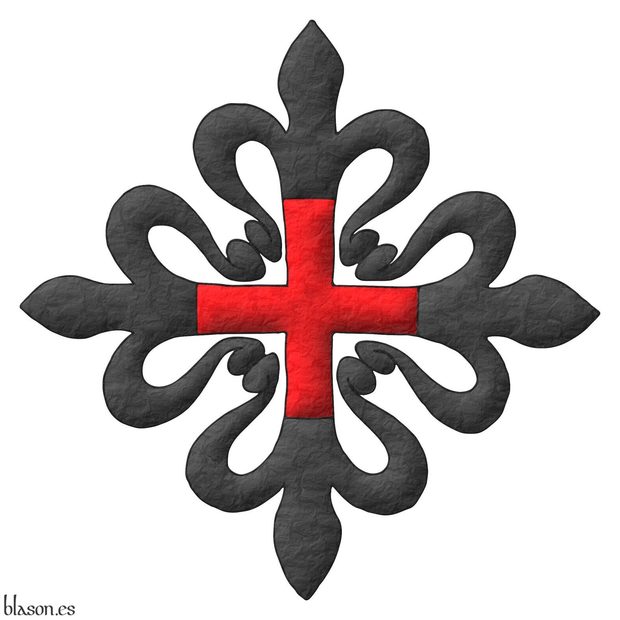
Order of Chivalry of Saint Mary of Montesa and Saint George of Alfama.
A cross of Montesa.
Una cruz de Montesa.
Interpretation of the emblem of the order with: its cross outlined in Sable, illuminated in Gules; and a highly hammered metal finish.
The Royal Council of the Orders of Chivalry of Santiago, Calatrava, Alcantara, and Montesa, in its historical review of the founding of the Order of Montesa, states that it was created in 1317, at the request of James II, King of Aragon, through a bull issued by Pope John XXII.
Emblem
About the emblem of the Order of Chivalry of Montesa [Avilés, J.; 1780b; treatise IV, chapter VI, page 342, figure 103], it states that «the Ensign of the Knights of Montesa is a plain red Cross», gules, «plain, which they wear on their Capitular Mantles, or hanging from a red ribbon on the chest over a gold oval; that is, on a field of gold a plain cross of gules (different from how the Masters wore it)» and, therefore, it describes the first emblem of the Order of Montesa and not the one they wear now, which is that same plain cross of gules charged on a cross like that of the Order of Calatrava or like that of the Order of Alcantara, but in Sable instead of Gules or Vert.
Blazon keywords: Cross of Montesa, Cross couped and Cross.
Style keywords: Illuminated, Outlined in sable and Soft metal.
Classification: Interpreted, Religious, Military and Emblem.
Bearer: Montesa, Order of.


Cavalry Regiment Montesa, royal crown
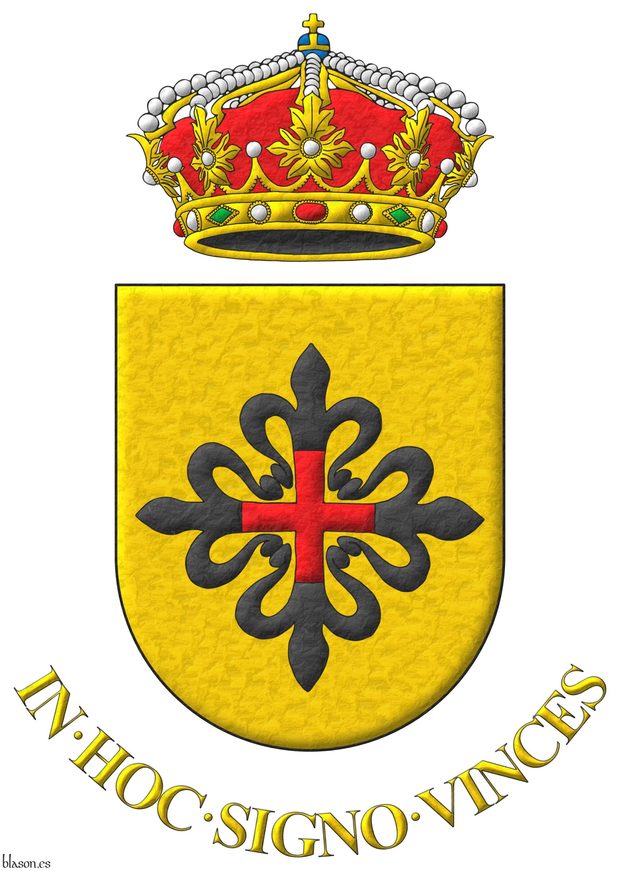
In this sign, you shall conquer.
Argent, a cross of Montesa. Crest: A closed royal crown Or, with eight arches, visible five. Motto: «In hoc signo vinces».
Escudo de oro, una cruz de Montesa. Timbrado de una corona real cerrada. Lema: «In hoc signo vinces».
Coat of arms interpreted as follows: the shape of the shield is a semi-circular arch; the field has been illuminated in metal Or; the cross of Montesa is outlined in Sable and illuminated in Sable and Gules; the royal crown is closed, outlined in Sable and illuminated the metal in Or, the pearls in Argent, the orb in Azure and Or, the gemstones in Gules and Vert, the inner cloth in Gules, and the visible hollow at its base in Sable; and the whole has a slightly beaten metal finish.
Regimental Motto
The Latin motto «In hoc signo vinces» is translated as «In this sign, you shall conquer».
Globus cruciger ~ Orb
It is called orb ~ «globus cruciger», the first in Spanish and the second in Latin, referring to the part of the royal crown, a jewel, or a jewel itself that recreates the shape of the globe topped with a cross.
Blazon keywords: Without divisions, Or, Cross of Montesa, Cross couped, Cross, Crest, Closed royal crown, Crown and Motto.
Style keywords: Semi-circular, Illuminated, Outlined in sable and Soft metal.
Classification: Interpreted, Military, Army and Navy and Coat of arms.
Bearer: Montesa, Cavalry Regiment.
-
Language
-
Categories of heraldry
-
Divisions of the field
- Without divisions
- Party per pale
- Party per fess
- Party per bend sinister
- Tierce
- Tierce sinister
- Tierced per fess
- Tierced per bend
- Tierced pallwise inverted
- Quarterly
- Quarterly per saltire
- Gyronny
- Party per fess, the chief per pale
- Party per pale, the sinister per fess
- Party per fess, the base per pale
- Party per pale, the dexter per fess
- Chapé
- Chaussé
- Party per chevron
- Enté en point
- Flanched
-
Metals
-
Colours
-
Furs
-
Other tinctures
-
Ordinaries and sub-ordinaries
-
Diminutives of the ordinaries
-
Other charges
-
Charges from Nature
Water, Eagle, Bald eagle, Eagle claw, Dorsal fin, Tail fin, Two hands clasped, Lark, Tree, Trunk, Rainbow, Atom, Barbel, Acorn, Bighorn sheep, Arm, Owl, Vulture, Horse, Head, Goat, Camellia, Thistle, Merino ram, Kapok tree, Stag, Doe, Crescent, Increscent, Chrysanthemum, Tail, Tail addorsed, Ermine spot, Hummingbird, Snowflake, Heart, Roe deer, Neck, Roe deers' attires, Raven, Dolphin, Diamond, Tooth, Elephant, Emerald, Starling, Mullet, Mullet of four points, Star of David, Estoile, Male figure, Fleur de lis, Flower, Cornflower, Dogwood flower, Lotus flower, Hop cone, Bluebonnet, Puffin, Ash, Rooster, Claw, Talon, Goose, Heron, Seagull, Pomegranate, Sunflower, Swallow-tail, Falcon, Leaf, Boar, Goldfinch, Laurel, Barn owl, Lion, Lioness, Lion passant, Leopard, Lion rampant guardant, Lynx, Lily, Madonna lily, Flame, Wolf, She-wolf, Parrot, Moon, Hand, Apple, Apple tree, Martlet, Wing, Two wings in vol, Covert, Blackbird, Mount, Trimount, Fly, Wrist, Elm, Olive tree, Orbital, Bear, Palm frond, Palm tree, Dove, Poplar leaf, Panther, Jaguar, Vine, Paw, Forepaw, Foot (palmiped), Foreleg, Peacock, Chest, Pelican, Pelican in her piety, Dog, Brach hound, Fish, Hoof, Beak, Quill, Cinquefoil, Quetzal, Branch, Sprig, Frog, Shamrock, Caboshed, Oak, Holm oak, Rose, Double rose, Savage, Serpent, Plough of Ursa Major, Sun, Sun in splendour, Ray of the sun, Lightning flash, Stem, Badger, Tyger, Linden, Wheat, Wheat spike, Bull, Tulip, Udder, Escallop and Fox.
-
Artificial charges
Halberd, Plough share, Ace of spades, Anchor, Cyclamor, Torch, Bow, Arch, Harp, Non-classic artifact, Winnowing fan, Crozier, Conductor's baton, Pair of scales, Ship, Norman ship, Beret, Grenade, Ecclesiastical cap, Arm vambraced, Knight, Chain, Covered cup, Monstrance, Bell, Bell tower, Cannon dismounted, Carbuncle, Castle, Ribbon, Clarion, Nail, Cord, Dagger, Key ward, Turret, With a turret, Armillary sphere, Sword, Federschwert, Sabre, Parchment, Scroll, Arrow, Club, Garb, Sheaf of tobacco, Scythe, Gauntlet, Axe, Buckle, Galician granary, Polish winged hussar, Church, Oil lamp, Spear, Spear's head, Fleam, Letter, Book, Open book, Closed book, Bookmark, Page, Line, Lantern, Key, Four crescents joined millsailwise, Hammer, Menorah, Mortar, Pestle, Number, Knot, Celtic Trinity knot, Water-bouget, Comb, Piano, Millstone, Millrind, Millwheel, Clay pot, Bridge, Cuffed, Hourglass, Chess rooks, Compass rose, Rosette of acanthus leaves, Mullet of six points pierced, Broken, Portcullis, Wheel, Wagon-wheel, Symbol, Sackbut, Drum, Geometric solid, Tetrahedron, Tower, Trident, Trumpet, Double vajra and Anvil.
-
Immaterial charges
Angel, Heart enflamed, Sacred Heart of Jesus, Paschal lamb, Dragon, Wyvern, Phoenix, Garuda, Griffin, Sea-griffin, Winged hand, Our Lady of Mercy, Pegasus, Saint George, Mermaid, Trinity, Triton, Golden fleece, Unicorn and Ouroboros.
-
External elements
-
Heraldic creations
-
References
-
Formats
-
Keywords on this page
Behind the shield, Between, Pointed, Armed, Azure, Boa, Wreath, Chevron, Charged, Crest, Ogee, Crown, Created, Cross, Eight-pointed cross, Cross of Jerusalem, Cross patty, Cross potent, Cross couped, Quarterly, Four, Outlined in sable, Two, Emblem, In chief, In base, Coat of arms, Personal, Gules, Illuminated, Interpreted, Chief, Mantling, Motto, Lion, Semi-circular, Soft metal, Military, Knights Templar, Or, Argent, Without divisions, Rampant, Religious, Sable, Vert, Freehand, Three and One.
